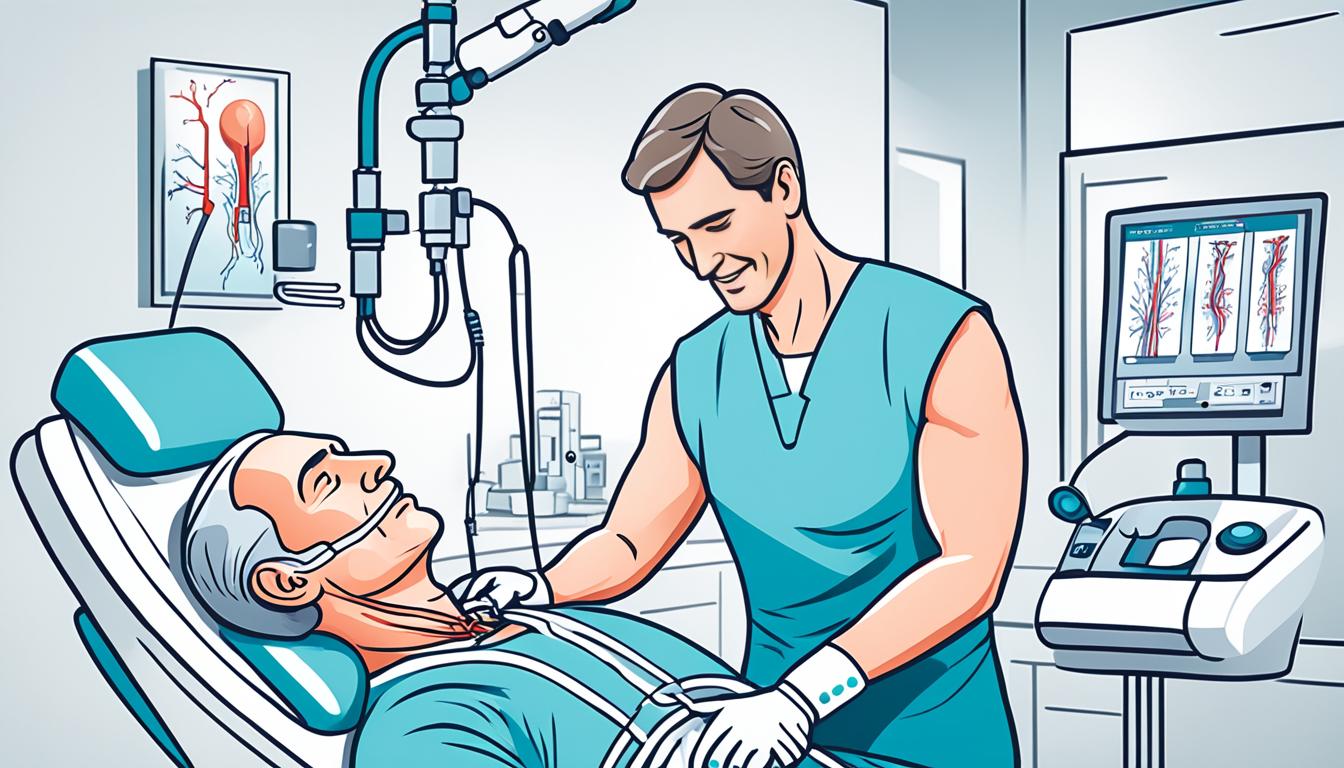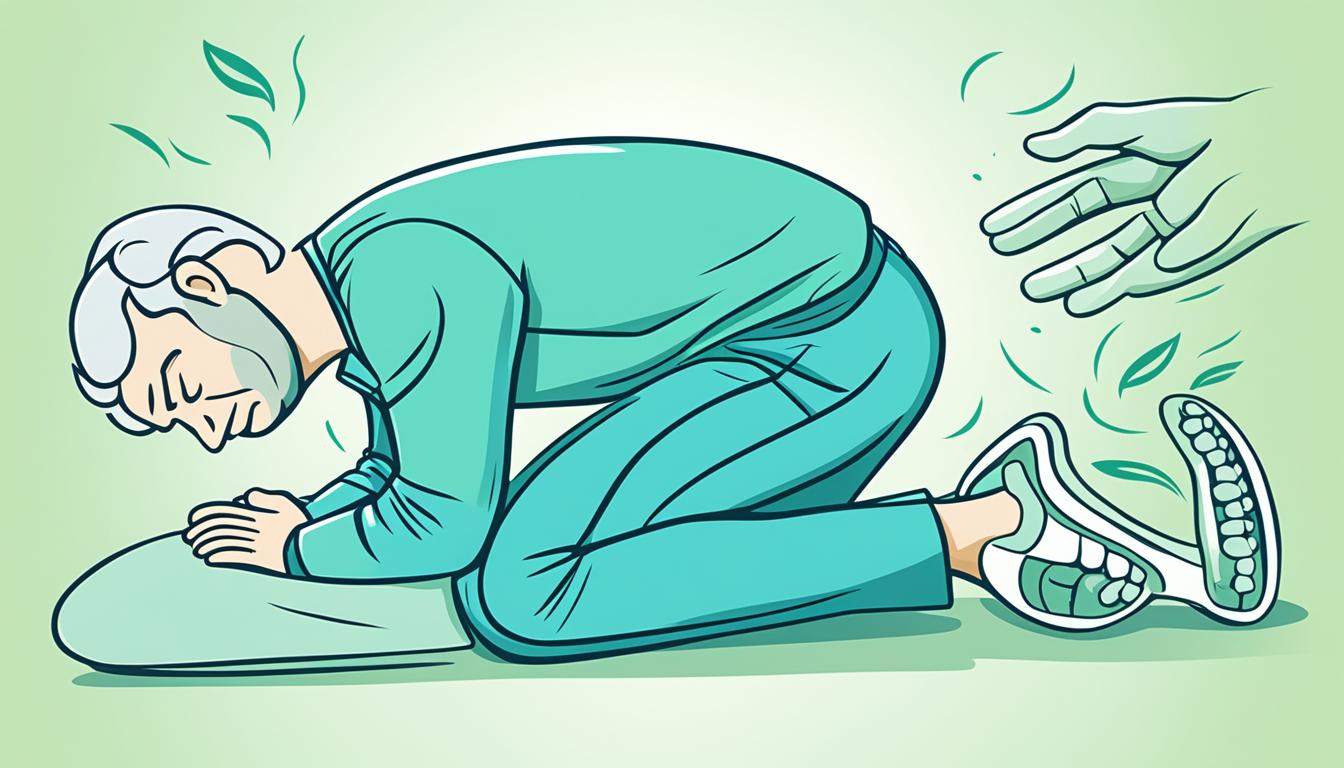Top Procedures Offered by Interventional Pain Specialists
We are interventional pain specialists in India, offering advanced, minimally invasive procedures for chronic pain. Our team uses the latest techniques and X-ray or ultrasound imaging. This ensures we target the pain source accurately, offering relief without surgery or long-term meds.
If you're facing joint pain, nerve issues, or spinal problems, we can help. Our specialists create a treatment plan just for you. We offer options like epidural steroid injections and radiofrequency nerve ablation. Plus, we have regenerative therapies like platelet-rich plasma (PRP) for effective pain relief.
We combine cutting-edge techniques with a focus on you, the patient. Our goal is to improve your life and let you enjoy activities you love. Trust us to provide the care you need for chronic pain management.
Introduction to Interventional Pain Management
Interventional pain management is a way to find and treat the cause of chronic pain. It uses advanced, non-invasive methods. Specialists in this field are trained to create personalized treatment plans. They aim to treat the root cause, not just the symptoms.
This approach is for people with chronic pain that hasn't gotten better with other treatments. Specialists use treatments like trigger point injections and nerve blocks. These methods help provide lasting relief and improve life quality.
These procedures work well for many pain conditions, including myofascial pain and chronic headaches. Each patient's results can vary. But the goal is to use less invasive methods to reduce pain and enhance well-being.
Specialists in interventional pain management work with other health experts. They include physical therapists and primary care doctors. Their focus is mainly on the spine and joints, helping with neck, back, and muscle issues.

Minimally Invasive Procedures for Chronic Pain Relief
Minimally invasive procedures are changing the game for chronic pain management. These methods offer targeted treatments that are less invasive than traditional surgeries. This means less pain, quicker recovery, and fewer complications for patients.
Vertiflex Superion® Indirect Decompression
The Vertiflex Superion® Indirect Decompression is a key example. It helps with lumbar spinal stenosis symptoms. A small, flexible device is placed between two vertebrae through a tiny cut. This creates more space in the spinal canal to ease nerve pressure.
Dekompressor Discectomy
The Dekompressor Discectomy targets compressed nerve pain from herniated discs. Doctors use a small tube and drill to shave a tiny part of the disc nucleus. This gives nerves more room to breathe.
Intradiscal Electrothermal Therapy (IDET)
IDET is for those with lower back pain from herniated discs or degenerative disc disease. A catheter and heating wire are inserted near the disc. Heat thickens the disc's collagen, closing small tears and cracks.
These procedures offer hope for chronic pain relief. They can improve life quality and help patients stay active. By targeting pain causes, patients see symptom relief and better overall health.
Injections for Pain Management
Interventional pain specialists offer targeted injections for chronic pain. These procedures are minimally invasive. They help with pain in the spine, joints, and other body areas.
Epidural Steroid Injections
Epidural steroid injections help with pain in the neck, shoulders, arms, and more. This pain can come from a herniated disc, degenerative disc disease, or arthritis. Doctors use X-rays to inject anti-inflammatory pain medications right where it hurts.
This reduces inflammation and brings relief.
Facet Joint Injections and Medial Branch Blocks
These injections are guided by X-rays and target the small spine joints. Arthritis in these joints can cause pain in the head and back. The procedure takes about 5 minutes and can be done with local anesthesia or sedation.

Radiofrequency Procedures
If you have chronic back or neck pain, radiofrequency nerve ablation might help. This procedure uses heat to temporarily block the nerves that cause pain. It's done with X-rays to guide it and can ease pain for six months to two years.
This method treats many pain types, like facet joint pain and discogenic back pain. It's great for chronic pain that other treatments haven't helped.
Pulsed radiofrequency (PRF) and water-cooled radiofrequency (WCRF) are top choices for pain relief. Cryoneurolysis uses cold to stop nerve function, without causing more sensitivity or neuromas.
The procedure takes about 20 minutes and you can go back to normal in 1-3 days. It's done with local anesthesia or light sedation. Experts with lots of experience should do it for the best results and safety.

Are you tired of back or neck pain? Talk to your doctor about radiofrequency nerve ablation. This new treatment can give you lasting relief and improve your life.
Interventional pain specialists for Joint Pain Relief
Interventional pain specialists offer effective treatments for joint pain. They perform major joint injections and muscle and joint injections under ultrasound guidance. These procedures help manage pain from conditions like osteoarthritis.
Major Joint Injections
Major joint injections can ease pain for those with osteoarthritis or other joint issues. Specialists use X-rays or ultrasound to guide the injection. They inject medications like corticosteroids or hyaluronan into the joint.
This targeted treatment reduces pain and improves mobility. The whole process takes about 2 minutes.
Muscle and Joint Injections Under Ultrasound Guidance
For neck pain and tennis elbow, specialists use ultrasound-guided injections. They inject a local anesthetic and a low-dose steroid into the affected area. This method is minimally invasive and can greatly reduce pain and improve function.
The procedure usually takes around 15 minutes.
If you're struggling with joint or muscle pain, our clinic's interventional pain specialists can help. They aim to relieve your pain and enhance your quality of life.

Advanced Regenerative Therapies
Platelet-Rich Plasma (PRP) Therapy
Platelet-rich plasma (PRP) therapy uses your body's healing powers. It's a way to heal soft tissue injuries like ligaments and tendons, and even cartilage injuries. This therapy uses your own blood to help you heal.
First, your doctor takes a small blood sample from your arm. Then, this blood is spun in a centrifuge to get the platelets. These platelets are full of growth factors that help healing. The platelet-rich plasma is then injected into the injured area, using ultrasound for accuracy.
You might start feeling better and less pain in about 6 weeks after PRP therapy. This treatment uses your body's healing powers to fix the injury. It helps you avoid surgery and long recovery times, so you can enjoy activities again.

If you have a soft tissue, tendon, or cartilage injury, consider PRP therapy. It's a natural way to lessen pain and aid in recovery.
Nerve Blocks for Targeted Pain Relief
Nerve blocks are a great way to target pain relief. The occipital nerve block is especially helpful for headaches and migraines. These nerves at the back of the head send pain signals from the head and neck.
A healthcare provider, often an interventional pain specialist, injects a local anesthetic and sometimes a small dose of corticosteroid into the area of the greater and lesser occipital nerves. This quick procedure, taking about 30 seconds, can bring fast pain relief for many people.
Occipital Nerve Blocks
Occipital nerve blocks are great for those with recurrent headaches, migraines, or other head and neck pain. It stops pain signals through the occipital nerves, helping to ease discomfort.
- Occipital nerve blocks are a proven and safe way to treat chronic headaches and migraines.
- The procedure is quick, taking just a few minutes, and relief can last weeks or months.
- It's often used with other treatments, like preventive medicines, for better pain control.
For those looking for relief from occipital nerve blocks, headaches, or migraines, this procedure can be a big help. Working with an interventional pain specialist, patients can find a targeted way to manage their pain and enhance their life quality.

Spinal Interventions
Interventional pain specialists offer advanced procedures for chronic spinal conditions. These include kyphoplasty (balloon kyphoplasty) and spinal cord stimulation.
Kyphoplasty (Balloon Kyphoplasty)
Kyphoplasty, or balloon kyphoplasty, is a minimally invasive treatment for spinal fractures, like vertebral compression fractures. A small balloon is inserted through a tiny incision in the back. It goes to the fracture site.
The balloon is then inflated to move the broken bone back into place. After that, a cement-like material is injected to keep the area stable. This whole process is done under local anesthesia and sedation in an operating room.
Spinal Cord Stimulation
Spinal cord stimulation helps manage chronic pain, including failed back surgery pain and complex regional pain syndrome (CRPS). First, a trial phase involves placing an electrode on the skin to stimulate the spinal cord.
If it helps with pain, a permanent electrode is put under the skin, near the spinal nerves or cord. Patients learn how to use the electrical stimulation to block pain signals. This gives them long-term relief.

Interventional pain specialists are key in picking the right spinal intervention for each patient. They use these advanced methods to help patients find lasting relief from chronic spinal pain. This improves their quality of life.
Interventions for Abdominal Pain
Managing persistent abdominal pain can be tough. But, interventional pain management techniques can help a lot. One effective method is the celiac plexus block. This involves injecting medication into or near the nerves around the main abdominal artery. It blocks pain signals from the abdomen to the brain.
The celiac plexus block is great for treating pain from chronic pancreatitis, abdominal adhesions, and some cancers. It stops pain from traveling to the brain. This procedure is minimally invasive and can give relief for weeks or months. It's also a good option for those who haven't found relief with regular pain meds.
This block is done under image guidance like fluoroscopy or ultrasound. It's usually done as an outpatient. After the procedure, you might feel numbness or weakness in your abdomen. But these effects are usually mild and go away in a few hours. It's important to follow post-procedure care to avoid any complications.
If you're dealing with ongoing abdominal pain, the celiac plexus block could be a game-changer. It offers targeted relief and can improve your quality of life.
Implantable Pain Management Devices
Intrathecal Pump Implant
For people with chronic pain from cancer, pancreatitis, or complex regional pain syndrome, or spasticity from disorders like multiple sclerosis and cerebral palsy, the intrathecal pump implant can change their lives. This device is placed surgically by pain specialists. It delivers a steady dose of pain medicine right to the spinal cord for long-term relief.
The surgery is done through a small cut in the abdomen. The pump is put near the spinal cord. Patients then see their doctor regularly for refills or adjustments. This method targets pain at its source. It helps manage chronic pain, cancer pain, and spasticity without the usual side effects of oral drugs.
Interventional pain management has evolved a lot. The intrathecal pump implant is now a top choice for treating severe, ongoing pain. With the help of their healthcare team, patients can find relief and improve their quality of life with this and other new treatments.
Procedure Selection by interventional pain specialists
Managing chronic pain requires the expertise of interventional pain specialists. They create personalized treatment plans. They use advanced, minimally invasive procedures to target pain at its source.
The choice of procedure depends on the patient's condition, medical history, and pain symptoms. It also depends on the specialist's skills and experience. This ensures the treatment plan meets the patient's specific needs for the best results.
Our clinic's specialists use a team approach to manage pain. They know a lot about the body's anatomy, how to examine patients, and how to use imaging and other tests. This helps them find the real cause of pain and choose the right procedure for relief.
If you have spinal injuries, degenerative disc disease, pinched nerves, arthritis, joint disorders, or pain from past surgeries, our specialists can help. They create a treatment plan just for you to help you take back control of your life.
Getting certified as an interventional pain specialist is tough. They must finish an Anesthesiology residency, work in pain management for two years, and pass a big exam. This ensures they have the skills and knowledge for top-notch treatments.
Our specialists are all about offering the latest, least invasive procedures. They aim to give you lasting pain relief and improve your life quality.
Risks and Complications of Interventional Pain Treatments
Interventional pain treatments can help relieve pain, but they also come with risks and complications. These risks are rare but can include infection, bad reactions to medicines, and blockages from injecting into a blood vessel.
Doctors take steps to lower these risks. They use clean techniques, watch the medicine amounts, and use imaging to place the needle right. Some people, like those with infections or blood clotting problems, might need special care or shouldn't have these treatments.
Here are some complications that can happen with these treatments:
- Bacterial meningitis and cauda equina syndrome from epidural steroid shots
- Risks of epidural and transforaminal steroid shots in the spine, including cases of paraplegia
- Discitis after lumbar epidural corticosteroid injection
- Paralysis following transforaminal epidural injection combined with previous spinal surgery
- Hematogenous pyogenic facet joint infections
- Cerebrospinal fluid (CSF) leakage and post-dural puncture headaches from epidural injections
- Epidural hematomas and intramedullary spinal cord hemorrhage following lumbar and cervical epidurals
- Epidural abscesses and bacterial meningitis after lumbar interlaminar injections
Even though complications are rare, it's important to talk about the risks and benefits with your interventional pain specialists before starting a treatment. Choosing the right patients, following safety steps, and watching closely can help make these treatments safer and more effective for pain relief.
Conclusion
If you're dealing with chronic pain, there's hope for lasting relief. Specialists in India offer advanced, minimally invasive treatments. They use the latest techniques to target the root of your pain. This means more than just masking your symptoms.
These experts help you take back control of your life. They offer solutions for back, neck, or joint pain. Options like epidural injections and radiofrequency ablation can bring you long-term relief.
Don't let chronic pain control your life. Discover how interventional pain management can change everything. Reach out to the experts at the Medical Rehabilitation Center in Kolkata. They'll find a custom solution for you, leading you to a life without pain.
FAQ
What types of advanced, minimally invasive procedures do interventional pain specialists in India offer?
How does interventional pain management differ from traditional pain treatment?
What is the Vertiflex Superion® Indirect Decompression procedure?
How does the Dekompressor Discectomy procedure work?
What is Intradiscal Electrothermal Therapy (IDET)?
How do epidural steroid injections help with pain relief?
What are facet joint injections and medial branch blocks?
How does radiofrequency nerve ablation work?
What types of joint injections are available?
How does platelet-rich plasma (PRP) therapy work?
What are occipital nerve blocks used for?
How does kyphoplasty (balloon kyphoplasty) work?
What is spinal cord stimulation used for?
What is the celiac plexus block used for?
What is the intrathecal pump implant used for?
How do interventional pain specialists select the appropriate procedure for each patient?
What are some of the potential risks and complications of interventional pain procedures?
Risks from these procedures are rare but can include infection and adverse effects from medications. Doctors take steps to minimize these risks. Patients with certain conditions may need extra precautions.
Source Links
- Interventional Pain Management Procedures | Mount Sinai
- What is Interventional Pain Management?
- Interventional Pain Management Procedures | Heilman Center
- Interventional Pain Management - an overview
- A comprehensive overview and scope of interventional pain management
- What is Interventional Pain Management? | OrthoVirginia
Common Adult Mental Health Issues
Mental health issues are a big problem in the U.S., touching the lives of millions of adults yearly. About 26% of Americans ages 18 face a mental disorder each year. This means 1 in 4 adults deal with a mental health issue. Often, people have more than one condition, like depression, substance use, and anxiety.
These adult mental health disorders greatly affect daily life, relationships, and happiness. It's important to understand how common they are and their effects. This knowledge helps us work towards better support for those struggling.
Introduction to Adult Mental Health Disorders
Mental health disorders are a big concern for adults in the U.S. These conditions can really change how someone lives their life. They affect social, work, and overall health. It's important to understand how common and how these disorders affect adults.
Prevalence of Mental Disorders in Adults
About 9.5% of American adults ages 18 and up will have a depressive illness yearly. This includes major depression, bipolar disorder, or dysthymia. Around 18% of people ages 18-54 will have an anxiety disorder. This includes panic disorder, OCD, PTSD, and GAD.
These disorders are common and can greatly affect someone's life quality.
Impact of Mental Disorders on Daily Life
Having more than one mental disorder can make life harder. People with multiple conditions struggle more in social, work, and personal areas. These disorders can make it tough to keep relationships, jobs, and can lower overall happiness and life quality.
It's key to tackle the daily life effects of mental disorders to help adults feel better.
Anxiety Disorders in Adults
Anxiety disorders are common mental health issues in adults. They can greatly affect daily life with too much worry, fear, and physical symptoms. Generalized Anxiety Disorder (GAD) and Panic Disorder are two main types.
Generalized Anxiety Disorder (GAD)
Generalized Anxiety Disorder (GAD) means feeling too much worry and anxiety about many things. People with GAD struggle to control their worried thoughts. This can cause restlessness, tiredness, trouble focusing, being easily annoyed, muscle tension, and trouble sleeping.
This worry and anxiety must happen often for at least 6 months to be diagnosed with GAD.
Panic Disorder and Agoraphobia
Panic disorder is about having sudden, intense fear or discomfort without warning. People with this disorder might avoid places or situations that could cause these attacks. This can lead to agoraphobia, a fear of being in places where getting out might be hard or embarrassing.
This avoidance can make panic disorder symptoms worse and affect daily life a lot.

It's important to recognize and get help for anxiety disorders. They can really affect someone's well-being and life quality. By understanding symptoms and getting professional help, people with anxiety can manage their condition better and improve their daily life.
Depressive Disorders in Adults
Many adults struggle with depression, a common mental health issue. There are two main types: Major Depressive Disorder (MDD) and Persistent Depressive Disorder (PDD), also known as dysthymia. Knowing the signs of these conditions helps people get the help they need.
Major Depressive Disorder
Major Depressive Disorder makes people feel sad or lose interest in fun activities. Those with MDD might feel tired, irritable, or want to be alone. They could also have trouble sleeping, eating, or feel guilty and not good enough. Some might even think about ending their life.
Persistent Depressive Disorder
Persistent Depressive Disorder, or dysthymia, is a long-term feeling of sadness. People with PDD often feel bad about themselves and hopeless. They might find it hard to focus and feel like nothing will get better.
Knowing about depressive disorders and their signs is key to getting help. If you or someone you know is feeling down, it's crucial to talk to a mental health expert. They can guide you on how to manage these feelings.
Adult mental health
In the United States, many adults struggle with mental health issues. About 26% of adults, or 1 in 4, face a mental disorder each year. These disorders can greatly affect how people live their lives, their relationships, and their happiness.
Many things can make someone more likely to have a mental health issue. Being poor, facing violence, or dealing with inequality can make someone more at risk. Genetics and biology also play a part in some cases.
Mental health issues can really change a person's life. They can make it hard to keep relationships strong, do well at work, or feel good about oneself. Getting help from professionals is key to managing these issues.

We need to understand how common and how much mental health disorders affect adults. This knowledge helps us fight the stigma around these issues. By supporting research, education, and kindness, we can help adults with mental health problems. This way, we aim to make the mental health of adults better.
Post-Traumatic Stress Disorder (PTSD)
Post-Traumatic Stress Disorder (PTSD) is a mental health issue that can happen after a very scary or terrible event. It makes people relive the traumatic event through memories, flashbacks, or nightmares. They might also avoid thoughts and memories of the event and feel like they're always in danger.
About 3.5% of adults in the U.S. have PTSD in any given year. This condition can really change someone's life, affecting how they connect with others, work, and feel overall.
Some things make it more likely to get PTSD. These include going through or seeing a traumatic event, having mental health problems before, and dealing with ongoing stress or hard times. But not everyone who goes through a traumatic event will get PTSD. How bad the symptoms are can also vary a lot.
There are good treatments for PTSD, like trauma-focused cognitive-behavioral therapy and eye movement desensitization and reprocessing (EMDR). These have been proven to help people with PTSD handle their symptoms better and improve their life quality.
If you or someone you know is dealing with PTSD, getting help is key. With the right treatment and support, people with PTSD can learn to manage their symptoms and take back control of their lives.
Obsessive-Compulsive Disorder (OCD)
Obsessive-Compulsive Disorder (OCD) affects millions of adults in the U.S. It's marked by unwanted thoughts and compulsive behaviors. These thoughts and actions can really disrupt a person's life.
Types of Obsessions and Compulsions
Common obsessions include:
- Fear of contamination
- Concerns about causing harm to oneself or others
- Excessive focus on order or symmetry
- Intrusive sexual or religious thoughts
Compulsions can be actions or mental acts. They might be seen by others or not. Examples are:
- Checking locks or appliances for harm
- Washing hands a lot to avoid germs
- Counting or repeating phrases for order
- Hoarding items to an extreme extent
OCD can make everyday tasks hard and social activities tough. It causes a lot of distress and hinders personal and professional life.

Bipolar Disorder in Adults
Bipolar disorder is a mental health condition that affects many people around the world. It brings extreme mood swings, from feeling very energetic and happy to feeling very sad and down. It's important to know about the symptoms of bipolar disorder, its prevalence, and how it affects daily life.
People with bipolar disorder go through times of mania and depression. In mania, they might feel very energetic, happy, and want to take risks. But in depression, they might feel hopeless, tired, and not care about anything.
As of 2019, about 40 million people worldwide had bipolar disorder. This condition can make it hard for someone to live their life normally. It can affect relationships, work, and overall happiness. Getting the right treatment and support is key to managing symptoms and improving life.
Treatments for bipolar disorder include therapy, medicine, and changing daily habits. Learning about the condition, reducing stress, and sleeping well can help manage it. With the right care, many people with bipolar disorder can live happy and productive lives.
Understanding bipolar disorder is the first step to helping those affected. By spreading awareness and making treatments available, we can help people with this condition live better lives.
Eating Disorders in Adults
Eating disorders are a big mental health issue that can affect adults of all ages. These conditions involve a bad relationship with food, body image, and self-worth. Anorexia nervosa and bulimia nervosa are two common types.
Anorexia Nervosa
Anorexia nervosa makes people fear gaining weight a lot. They see their body differently and eat very little. Signs include not wanting to keep a healthy weight, thinking a lot about food and calories, and wanting to be very thin.
Bulimia Nervosa
Bulimia nervosa means eating a lot and then trying to get rid of it. People with this condition may feel bad about their body shape and weight. They often feel guilty, ashamed, and out of control.
If eating disorders are not treated, they can cause serious health problems. It's important for those affected to get help. They need to work on a healthy relationship with food and their body.
Disruptive Behavior and Dissocial Disorders
Disruptive behavior and dissocial disorders are important mental health topics. They involve patterns of behavior that disobey social norms and harm others. Conditions like conduct disorder and oppositional defiant disorder often start in childhood and affect daily life.
Recent stats show that in 2019, about 40 million people worldwide had conduct-dissocial disorder. This includes both kids and adults. These disorders show up in many ways, like aggression, breaking rules, and not following authority.
Handling these issues needs a full approach. This includes treatments that involve parents, teachers, and caregivers. Teaching cognitive problem-solving and social skills can help. It helps people with these disorders cope better and interact socially.
By understanding these disorders and their treatments, we can support those affected. This leads to healthier and more fulfilling lives.
- Types of disruptive behavior and dissocial disorders include conduct disorder and oppositional defiant disorder.
- Symptoms of conduct disorder may involve aggression, rule-breaking, and difficulty cooperating with authority figures.
- Effective treatments for disruptive behavior disorders often involve a combination of psychological interventions, such as cognitive problem-solving skills and social skills training.
Conclusion
Mental health disorders are common in the U.S., affecting about 26% of adults each year. These include anxiety, depression, PTSD, OCD, bipolar disorder, and eating disorders. These conditions can greatly affect daily life, relationships, and overall happiness.
It's important to focus on mental health to improve well-being for individuals and communities. Even though there are effective treatments, many don't get the care they need. By spreading awareness, making resources more accessible, and reducing stigma, we can support adult mental health.
You're not alone in your mental health struggles. There are many organizations and services ready to help you or someone you care about. Start your journey to better mental health by seeking help. Let's work together for a future where everyone has the support to flourish.
FAQ
What are the most common mental health disorders affecting adults in the United States?
In the U.S., many adults deal with anxiety and depression. They also face post-traumatic stress disorder (PTSD), obsessive-compulsive disorder (OCD), and bipolar disorder. Eating disorders like anorexia and bulimia are also common.
What is the prevalence of mental disorders among American adults?
How do mental health disorders impact an individual's daily life?
What are the key symptoms of generalized anxiety disorder (GAD)?
What are the main features of major depressive disorder?
How common is post-traumatic stress disorder (PTSD) and what are its key symptoms?
What are the main types of obsessions and compulsions in obsessive-compulsive disorder (OCD)?
What are the key features of bipolar disorder?
What are the main types of eating disorders that affect adults?
What are disruptive behavior and dissocial disorders, and how common are they?
These disorders are about acting out and not following rules. They include conduct disorder and oppositional defiant disorder. About 40 million people worldwide, including kids and teens, are affected.
How Pain and Spine Specialists Can Help Manage Chronic Pain
If you're one of the many adults dealing with ongoing back pain, there's hope. Pain and spine specialists have the skills to help you. They can make your life better by creating a plan that doesn't always need surgery.
These doctors know a lot about back pain and its causes, like disc problems, sciatica, and spinal stenosis. They offer many non-surgical treatments and other therapies. This helps you use less medicine and avoid more serious procedures.
A pain and spine specialist will work with you to find out what's causing your pain. Then, they'll make a plan just for you. This plan might include physical therapy, injections, and other treatments. These can help you feel better and move more easily.
Understanding Chronic Back Pain
Chronic back pain is a long-lasting and tough condition. It can really affect how you live your life. It's not just for older people; it can also come from injuries or other health issues. Knowing what causes chronic back pain is key to managing the pain well.
Common Causes of Chronic Back Pain
Some common causes of chronic back pain are:
- Arthritis of the spine, which can cause inflammation and stiffness in the back
- Spinal stenosis, a condition that leads to the narrowing of the spinal canal and can put pressure on nerves
- Disc problems, such as a herniated or bulging disc, which can cause pain and discomfort
- Myofascial pain syndrome, a chronic condition that involves muscle pain and tightness
When to Seek a Second Opinion
If your doctor has tried all they can and you're still in pain, getting a second opinion might help. A specialist in back pain can give you a clearer picture of what's causing your pain. This can lead to a better treatment plan for you.

Chronic back pain is complex and requires a team effort to manage. Working with your healthcare team and getting a second opinion when needed is crucial. This approach can help you find the right treatment and improve your quality of life.
Nonsurgical Treatment Options
For people with chronic back pain, there are many nonsurgical ways to feel better and live better. Physical therapy and a good home exercise plan are key to managing back pain.
Physical Therapy and Home Exercise Program
Physical therapy is very important for chronic back pain. Therapists create exercise plans just for you, based on your symptoms and comfort. These exercises help with core strength, flexibility, posture, and aerobic fitness at your own pace.
Doing exercises at home is crucial for keeping your spine strong and stable. Your therapist will tell you which exercises to do and how often. This way, you can keep improving even when you're not in the clinic.
- Core strengthening exercises to improve overall spinal stability
- Stretching and flexibility movements to enhance range of motion
- Posture retraining techniques to improve alignment and reduce strain
- Low-impact aerobic exercises to increase cardiovascular fitness

Working with your physical therapist and doing exercises at home helps you take charge of your chronic back pain. It also boosts your overall health and well-being.
Mindfulness and Meditation for Pain Management
Living with chronic back pain is tough on both your body and mind. A rehabilitation psychologist can help you with this. They suggest mindfulness, meditation, yoga, tai chi, and other strategies to control your nervous system and how it reacts to pain.
Mindfulness meditation is a big help for managing chronic pain. Studies show it can make life better and help you deal with pain challenges. It's a key part of pain management.
This type of meditation helps you stay in the moment without judging yourself. You can watch your pain and feelings without getting too caught up. Learning to be kind to yourself helps lessen the emotional pain that makes physical pain worse.
Research also shows that mindfulness meditation can lessen pain by changing how the brain works. It can reduce the brain's control over pain and increase how you feel sensations. This means it can change how you respond to pain, helping you manage it better.
If you have chronic back pain, fibromyalgia, migraines, or other ongoing pain, mindfulness and meditation can be very helpful. They can give you more control over your symptoms and improve your well-being.

Managing pain is a complex process. Working with pain and spine experts can help you find the best strategies for you. This includes mindfulness and meditation, among other approaches.
Role of Diet and Lifestyle Modifications
Keeping a healthy diet and lifestyle is key to managing chronic back pain. By changing your diet to an anti-inflammatory diet, you can find relief. Foods high in trans fats, refined sugars, and processed items can make inflammation and back pain worse. But, eating lots of fruits, veggies, whole grains, and lean meats can cut down on inflammation and boost spine health.
It's also vital to manage your weight well. Being overweight can put extra stress on your spine, causing pain. A nutrition expert can help you make better food choices and reach your weight goals.
- Prioritize an anti-inflammatory diet with plenty of fruits, vegetables, whole grains, and lean proteins.
- Limit processed foods, refined carbohydrates, and sugary drinks that can make inflammation worse.
- Drink at least 2-3 liters of water a day to stay hydrated.
- Think about adding supplements like omega-3s, turmeric, or ginger to support spine health.
Changing your lifestyle habits like pacing activities, quitting smoking, and getting enough sleep can also help with pain. Breaking up your activities and resting can prevent more strain on your spine. Stopping smoking is crucial because it can lead to osteoporosis, arthritis, and other conditions that make back pain worse.

Slowly and steadily changing your diet and lifestyle can greatly improve your chronic back pain. Talk to your doctor or a specialist to create a plan that fits you best.
Injection-Based Treatments
If you're dealing with chronic back pain, injection treatments like trigger point injections and nerve blocks might help. These methods target the pain source directly. They can also help figure out the cause if the pain doesn't go away.
Trigger Point Injections and Epidural Steroid Injections
Trigger point injections put a local anesthetic or steroid right into the muscle knot to relax it. Epidural steroid injections send medicine to the area around the spinal cord to lessen inflammation and pain.
These injections can ease your pain for a while but aren't meant to be a long-term fix. They aim to help you manage your pain better. This way, you can do more gentle activities like physical therapy and exercises at home.
Nerve Blocks and Ablations
Nerve blocks stop pain signals from a specific nerve, helping with conditions like radiculopathy or spinal stenosis. Nerve ablations use heat to disable the nerve, which can give you lasting pain relief.
Talk to your healthcare provider about the pros and cons of these treatments. They can help you decide if they're right for managing your chronic back pain.

Exploring Alternative Therapies
Managing chronic back pain can be tough, and traditional treatments might not always work. Luckily, there are other ways to help. Acupuncture and massage are two options worth looking into.
Acupuncture, Massage, and Biofeedback
Acupuncture is an ancient Chinese method that helps with pain and healing. It's used for many conditions, like chronic back pain and headaches. This therapy works by using tiny needles to balance energy and reduce swelling.
Massage therapy is great for chronic back pain too. It eases muscle tightness, boosts blood flow, and helps you relax. This can lead to less pain and better movement. Many people use massage to help with back and neck pain.
Biofeedback therapy is another option for managing pain. It uses devices to track and give feedback on things like muscle tension and skin temperature. This helps you learn to control your body's pain response.
These therapies are usually safe and can be used with other treatments like physical therapy and medication. Talking to your doctor can help figure out the best plan for you.
Pharmacologic Treatments for Chronic Pain
Dealing with chronic back pain often means using different kinds of medications. Anti-inflammatories, muscle relaxants, nerve pain medications, and antidepressants can help. They target the root causes of your pain.
Anti-Inflammatories and Muscle Relaxants
Anti-inflammatory drugs like NSAIDs can lessen inflammation and ease pain. Muscle relaxants help with muscle spasms and tension. But, it's key to talk to your doctor to find the right mix of medications. Each drug has possible side effects.
Your doctor might start you on a low dose and watch how you react. The aim is to control your pain without bad side effects.
Opioids can help with short-term pain but aren't usually the first choice for long-term back pain. This is because they can lead to tolerance, dependence, and addiction.

By working with your pain and spine specialist, you can try different medications. This way, you can find the best way to manage your chronic back pain.
When is Surgery Recommended for Back Pain?
Surgery is a last resort for chronic back pain. It's the most invasive and risky option. It should be considered only if the pain's cause is clear from tests and other treatments haven't helped. "Red flag" symptoms like bowel/bladder issues, limb weakness, gait problems, or increased reflexes also play a role in deciding if surgery is needed.
Specialists recommend surgery only after trying non-surgical treatments like physical therapy, medications, and injections without success. Most back pain gets better on its own within three months without surgery. But for issues like disk problems, bone overgrowth, or instability, surgery might be the best choice.
Common surgical options for chronic back pain include diskectomy, laminectomy, spinal fusion, and artificial disk replacement. These procedures can help, but up to 40% of back surgeries may not work, leading to "failed back surgery syndrome." Risks include paralysis, infections, and a long recovery.
Because back surgery is complex and uncertain, getting a second opinion from a spine specialist is wise before surgery. This ensures surgery is the best choice for your condition and needs.
Multidisciplinary Pain and Spine Specialists
Managing chronic pain is easier with a team approach. Pain specialists, spine experts, and healthcare providers work together. They address your condition from different angles, ensuring coordinated care.
The team includes:
- Pain management specialists
- Anesthesiologists
- Specialists in any other medical conditions you may have
- Nurses
- Mental health providers
- Physical and/or occupational therapists
- Social workers
This team aims to cover all parts of your chronic pain, from physical to emotional and psychological. Together, they create a detailed plan to help you manage your pain and enhance your life quality.
Diagnostic Tests for Chronic Pain
If you're dealing with ongoing pain, your healthcare team might suggest several tests to find the cause. These tests include a detailed physical exam, a neurological exam, and imaging tests and electrodiagnostic studies.
The physical exam checks your overall health, touches the painful spots, and looks at how well you move. The neurological exam tests your reflexes, muscle strength, and how sensitive you are to touch. This helps spot nerve problems.
- Imaging tests like X-rays, MRI, and CT scans show issues like herniated discs, bone problems, or soft tissue injuries.
- Electrodiagnostic studies, including nerve conduction studies and electromyography (EMG), pinpoint nerve conditions causing your pain.
By looking at all these test results, your pain management team can make a plan to fix the main cause of your pain. This way, they can help you find relief.
Interventional Pain Management Procedures
If traditional treatments don't help with chronic pain, interventional pain management might be the answer. These procedures are minimally invasive. They aim to find and treat the root of your pain. This helps you move past your daily pain and do what you love again.
Some of these procedures include transcutaneous electrical nerve stimulation (TENS), peripheral nerve stimulation, spinal cord stimulation, radiofrequency ablation, and neuromodulation.
- Transcutaneous Electrical Nerve Stimulation (TENS) uses mild electrical currents to stop pain signals. This helps with different kinds of chronic pain.
- Peripheral nerve stimulation targets specific nerves to block pain signals. It's used for neuropathic pain and complex regional pain syndrome.
- Spinal cord stimulation means putting in a device that sends electrical impulses to the spinal cord. This stops pain signals from getting to the brain.
- Radiofrequency ablation uses heat to block pain signals from certain nerves. It gives long-lasting relief for chronic back pain and arthritis.
- Neuromodulation techniques, like intrathecal drug delivery systems, send medication directly to the affected area. This reduces side effects and improves pain control.
These procedures are made to fit your specific needs. They offer various options to help you manage your chronic pain and enhance your life quality.
Clinical Trials and Research in Pain Management
Researchers are looking into many new ways to manage pain. Pain doctors often run their own studies on patients who haven't found relief with usual treatments. If you're interested, talk to your doctor about joining a clinical trial. It could give you access to new treatments.
The NIH HEAL (Helping to End Addiction Long-term) Initiative is funding many clinical trials. They're working on new pain treatments that don't involve opioids. This is part of the effort to tackle the opioid crisis and find better ways to handle chronic pain.
- The Advancing Health Equity in Pain Management program works to reduce health gaps in pain care for different groups.
- The Acute to Chronic Pain Signatures program tries to figure out who might develop chronic pain after surgery or injury.
- The Back Pain Consortium (BACPAC) is all about finding new ways to treat chronic low back pain.
- The Discovery and Validation of Biomarkers for Chronic Pain study looks for biomarkers to help pick the right patients for trials.
There's also the Early Phase Pain Investigation Clinical Network, which tests new non-addictive pain treatments. The HOPE consortium looks into non-addictive options for hemodialysis patients. And the Pain Management Effectiveness Research Network checks out both drug and non-drug ways to ease pain.
These are just a few examples of the exciting work in pain management research and clinical trials. By keeping up with the latest and talking to your pain specialists, you can find out about new treatments that might help you.
The Role of Pain and Spine Specialists
Pain and spine specialists are key for handling chronic pain. They have special training to find the main cause of your pain and create the best treatment plan. They use many treatments and therapies to give you relief that lasts.
Diagnosis and Treatment Planning
At a pain and spine specialist's office, you'll get a detailed check-up to find out why you're in pain. They use the newest tools and methods to spot conditions that might be causing your pain. Then, they make a treatment plan just for you.
Coordinated and Ongoing Care
Pain and spine specialists don't just give you a diagnosis and treatment. They make sure your care is well-coordinated. They work with other health experts like physical therapists and neurologists to make sure you get the best care. They keep an eye on how you're doing and change your treatment as needed for ongoing relief.
Working with a pain and spine specialist is a big step towards managing your chronic pain and bettering your life. Visit https://www.phs.org/doctors-services/specialties/pain-spine to learn more about the services they offer.
Conclusion
Pain management and spine specialists in India are key to helping you with chronic pain and better life quality. They use a detailed, multidisciplinary approach. This includes various treatments, procedures, and care plans tailored just for you.
Looking into different options like physical therapy and mindfulness can help you take charge of your health. Specialists in pain and spine care in India also focus on teaching patients and working with other doctors. This ensures a complete and effective care plan
If you're dealing with chronic back pain, neck pain, or other spinal issues, specialists in pain management and spine care can really help. Their expertise and personal attention can greatly improve your path to pain relief and better health.
FAQ
What are the common causes of chronic back pain?
When should I consider seeking a second opinion for my chronic back pain?
How can physical therapy and a home exercise program help with chronic back pain?
How can mindfulness and meditation techniques help with chronic pain management?
What role does diet and lifestyle play in managing chronic back pain?
What are the different types of injection-based treatments for chronic back pain?
What alternative therapies can help manage chronic back pain?
How do medications fit into the treatment plan for chronic back pain?
When is surgery recommended for chronic back pain?
How do pain and spine specialists work as part of a multidisciplinary team?
What types of diagnostic tests may be recommended to evaluate chronic pain?
What are some of the interventional pain management techniques that may be used?
How can participating in clinical trials help with chronic pain management?
How can pain and spine specialists help manage my chronic pain?
Specialists in pain and spine have the training to treat your pain effectively. They diagnose and treat the root cause with a variety of treatments. This approach often reduces the need for surgery or heavy medication.
Source Links
- Idaho Falls Pain Management | Pain & Spine Specialists
- What Does Pain Management Do for Back Pain - New York Spine Surgery
- The role of a pain management specialist
Natural Home Remedies for Sleep Apnea
Is your partner complaining about your loud snoring? Do you wake up feeling more tired than when you went to sleep? If yes, you might be one of the millions silently living with sleep apnea.
Sleep apnea is a condition where you stop breathing for short periods during sleep. It can lead to serious health issues if not treated. While CPAP machines are common treatments, natural home remedies can also help. This article will look at home remedies for sleep apnea to improve your sleep and health at home.
Understanding Sleep Apnea
Sleep apnea is a common sleep disorder where your breathing stops and starts during the night. This happens when the airway gets blocked, making you stop breathing for short times. The main reason is the muscles in the throat relaxing, causing snoring and broken sleep.
What is Sleep Apnea and Its Causes?
Sleep apnea happens when the airway gets blocked, stopping your breathing during sleep. This is often because the muscles in the throat relax. Other causes include being overweight, having big tonsils or adenoids, nasal congestion, and changes in the throat and tongue as you age.
Symptoms and Potential Health Risks
Sleep apnea's symptoms include loud snoring, gasping or choking while asleep, feeling tired during the day, and trouble focusing. If not treated, it can lead to heart disease, high blood pressure, and memory issues. Seeing a doctor if you think you have sleep apnea is crucial for your health and happiness.
The Two Main Types of Sleep Apnea
Obstructive Sleep Apnea (OSA)
OSA is the most common form. It happens when the muscles in your throat relax too much and block airflow.
- The airway becomes narrow or closes completely.
- Breathing pauses trigger sudden wake-ups.
- Most people with OSA snore loudly.
Central Sleep Apnea (CSA)
CSA is less common and more neurological. Here, your brain doesn’t send the proper signals to your muscles to keep breathing.
- No physical blockage, but a disconnect between brain and muscles.
- Often seen in people with heart conditions or using opioids.
Risks of Untreated Sleep Apnea
Even if you think you can live with it, untreated sleep apnea damages your body over time.
- Increases the risk of stroke, high blood pressure, and heart failure.
- Leads to daytime fatigue, poor concentration, mood swings, and depression.
- Linked to type 2 diabetes and metabolic syndrome.
Stat: Nearly 936 million people worldwide suffer from OSA, but 80% remain undiagnosed.
Can You Treat Sleep Apnea Naturally at Home?
The answer: Yes, for many people. Especially those with mild to moderate cases.
Changing the way you sleep, eat, and breathe can have a big impact. But keep in mind, these home remedies for sleep apnea may not replace medical treatment for severe cases.
If you still feel exhausted, have high blood pressure, or wake up gasping, it’s time to see a doctor.
10 Proven Home Remedies for Sleep Apnea
These home remedies for sleep apnea are backed by research, not internet myths. Let’s explore them in detail.
1. Weight Loss and Sleep Apnea
Extra fat around your neck and belly puts pressure on your airway.
- Losing just 10% of your body weight can reduce symptoms significantly.
- Neck fat narrows the throat; belly fat pushes up against the lungs.
Losing weight may be the most effective sleep apnea lifestyle change for overweight individuals.

2. Positional Therapy
Your sleep position can either help or worsen your breathing.
- Sleeping on your back allows gravity to pull your tongue backward, blocking airflow.
- Sleeping on your side keeps the airway open.
- Try the tennis ball trick: sew a tennis ball into the back of your pajama top to avoid rolling onto your back.
- Use anti-snore pillows to maintain proper neck alignment.
3. Nasal Dilators and Breathing Strips
If nasal congestion is part of your problem, this remedy helps.
- Over-the-counter nasal dilators open your nostrils.
- Breathing strips lift and expand your nasal passages.
- Brands like Breathe Right are popular.
These tools can be part of alternative treatments for sleep apnea, especially for mild cases.
4. Tongue and Throat Exercises (Myofunctional Therapy)
These exercises strengthen the muscles in your mouth and throat.
- Singing exercises target throat muscles.
- Chewing gum builds jaw and tongue control.
- Blowing up balloons increases lung and throat strength.
Oropharyngeal exercises can reduce OSA severity by 50%. — American Journal of Respiratory and Critical Care Medicine, 2009
5. Herbal Remedies
Certain herbs help reduce inflammation and calm the nervous system.
- Peppermint oil can reduce airway swelling.
- Lavender oil helps promote deeper, calmer sleep.
- Drinking chamomile or valerian root tea before bed may relax throat muscles.
These remedies are part of natural remedies for sleep apnea that support better breathing and sleep quality.
6. Anti-Inflammatory Diet
What you eat affects your airway.
- Avoid processed sugar, dairy, and fried foods.
- Eat more green leafy vegetables, omega-3-rich fish, turmeric, and ginger.
- Drink plenty of water to keep airways moist.
Diet is a powerful tool in how to manage sleep apnea naturally.

7. Humidifiers in the Bedroom
Dry air irritates the nose and throat.
- Use a humidifier to maintain moisture in the air.
- Ideal humidity level: 30% to 50%.
- Look for humidifiers with essential oil trays for added benefits.
Moist air helps reduce snoring and improve breathing.

8. Quit Smoking & Limit Alcohol
Both these habits make sleep apnea worse.
- Alcohol relaxes throat muscles, increasing the risk of blockage.
- Smoking causes inflammation and swelling in the airway.
- Quit smoking and avoid drinking alcohol 4 hours before bed.
These sleep apnea lifestyle changes can drastically improve your symptoms.
In fact, studies find that people with sleep apnea drink about 25% more than those who don't or drink less.
By avoiding alcohol, especially before bed, and quitting smoking, you can help your airways stay clear.

9. Improve Sleep Hygiene
Poor sleep habits increase apneic episodes.
- Stick to a consistent bedtime and wake-up time.
- Avoid screens 1-2 hours before sleep.
- Use blackout curtains and reduce noise.
Good sleep habits enhance the effectiveness of all home remedies for sleep apnea.
10. Elevate Your Head While Sleeping
Keeping your upper body raised can prevent your airway from collapsing.
- Sleep at a 30 to 60-degree angle.
- Use wedge pillows or adjustable beds.
- Avoid stacking pillows which can strain your neck.
This simple fix can reduce nighttime breathing pauses.
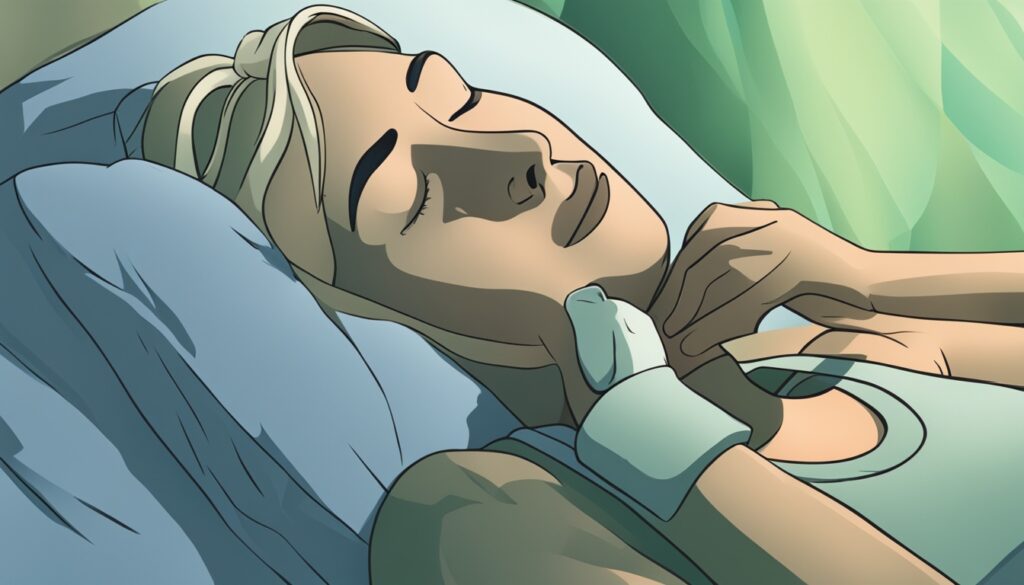
Myths About Natural Sleep Apnea Remedies
Not everything you read online is helpful. In fact, some things can be harmful.
| Myth | Fact |
|---|---|
| "Essential oils can cure sleep apnea." | They may help with relaxation but aren’t a cure. |
| "Just sleep more." | Sleep quantity doesn’t fix poor quality caused by breathing problems. |
| "DIY mouth devices are safe." | Ill-fitting devices can worsen your condition. |
| "Drinking alcohol before bed helps you sleep better." | Alcohol relaxes throat muscles and worsens airway blockage. |
| "Snoring is the same as sleep apnea." | Not all snorers have sleep apnea, but many with sleep apnea snore. |
| "You can’t have sleep apnea if you’re not overweight." | Thin people can also have anatomical or neurological causes of sleep apnea. |
| "Only older men get sleep apnea." | Women and even children can suffer from sleep apnea too. |
| "Natural remedies work instantly." | Home remedies require consistency and time to show results. |
Always talk to a doctor before trying new remedies.
The Benefits of Exercise for Sleep Apnea
If you have sleep apnea, adding regular exercise to your life can really help. Studies show that different types of physical activity, like brisk walking or intense workouts, can lessen sleep disruptions. This can also reduce the tiredness you feel during the day.
Regular exercise can make your breathing system stronger and help you sleep better overall. Even if you don't lose weight, staying active can ease sleep apnea symptoms. By being active, you might lower your risk of sleep problems and boost your health.
Here are some main benefits of exercise for sleep apnea:
- Improved respiratory function and fewer breathing disruptions
- Less daytime sleepiness and more energy
- Managing sleep apnea symptoms, possibly reducing CPAP therapy needs
- Potential weight loss to lessen sleep apnea severity
- Better heart health and overall well-being
Trying out different exercise routines for sleep apnea, like cardio, strength training, and yoga, can help manage this condition. Being consistent and dedicated to your workout plan is crucial to see the best results.

Side Sleeping: A Simple Yet Effective Solution
If you struggle with sleep apnea, changing how you sleep can help. Sleeping on your side can make a big difference. [https://www.sleepapnea.org/treatment/home-remedies-for-sleep-apnea/]
More than half of people with sleep apnea find it worse when sleeping on their backs. This is because your tongue can block your airway in this position. Sleeping on your side keeps your airways open and helps prevent breathing problems.
Using pillows or a tennis ball in a sock can help keep you on your side all night. Some research shows that sleeping on the right side works better for sleep apnea. This might be because it affects blood flow to and from the heart differently.
Sleeping on your stomach can also help a bit, but it's not the most common way for adults to sleep. Experts say to avoid back sleeping if you have sleep apnea. This is because your tongue can block your airway, making snoring and sleep problems worse.
Putting the head of your bed up about 60 degrees can also help. This position fights gravity and keeps your airway open. It can reduce snoring and make sleep better.
Changing how you sleep is a simple way to fight sleep apnea. But, it's important to talk to a doctor for the right diagnosis and treatment. This ensures you're tackling the real cause of your sleep apnea.
Exploring Alternative Therapies: Wind Instruments and Singing
CPAP is the top treatment for sleep apnea, but some studies show wind instruments and singing can help too. These activities need special breathing skills. They can make the muscles in the upper airway stronger. This might cut down on sleep apnea episodes.
Playing the didgeridoo, a unique wind instrument, can help with sleep apnea, research says. The deep breathing needed to play it can make the upper airway muscles stronger. This leads to fewer sleep apnea events, less daytime sleepiness, and less sleep trouble for others in the room.
Singing and certain exercises can also help people with sleep apnea, research finds. These activities can lower the apnea-hypopnea index, reduce snoring, and make sleep better.
Even though we need more studies, these alternative treatments could be good to try for some sleep apnea patients. Adding them to standard treatments might offer a more complete way to manage sleep apnea.
When Home Remedies Aren’t Enough?
Sometimes, symptoms persist even after trying every natural method.
Signs You May Need a CPAP or Medical Treatment
- Waking up gasping for air
- High blood pressure or irregular heartbeat
- Daytime sleepiness that affects work or driving
Stat: Only 50–60% of people stick to CPAP therapy. — Journal of Clinical Sleep Medicine
That’s why many people look for sleep apnea treatment without CPAP.
Expert Tips to Maximize Natural Remedies
If you want the best results, don’t rely on one method.
- Combine 3–4 remedies like weight loss, positional therapy, and breathing exercises.
- Track progress using a sleep tracker or smartwatch.
- Keep a journal noting bedtime, wake time, energy levels, and symptoms.
Real improvement takes time. Stay consistent.
Dr. Chandril Chugh’s Final Advice: Don’t Sleep on This Condition
Sleep apnea is serious, but you’re not powerless. With the right home remedies for sleep apnea, many people reclaim their nights and protect their health. Don’t wait for symptoms to get worse. Try these tips, track your progress, and stay alert to how you feel or consult a neurologist for sleep disorder treatments.
Still unsure where to start or not seeing results? Book a consultation with Dr. Chugh today. A simple evaluation could change your life or save it.
FAQ
What is sleep apnea and what causes it?
What are the common symptoms of sleep apnea?
How can maintaining a healthy weight help manage sleep apnea?
How can yoga and breathing exercises help with sleep apnea?
How does sleep position affect sleep apnea symptoms?
How can using a humidifier and essential oils help with sleep apnea?
How can avoiding alcohol and smoking help with sleep apnea?
What are oral appliances and how can they help with sleep apnea?
How does exercise benefit individuals with sleep apnea?
How can certain medications affect sleep apnea?
Some medications, like benzodiazepines and opioids, can make sleep apnea worse by relaxing airway muscles. If you're taking these, talk to your doctor about adjusting your treatment plan.
Source Links
- 6 Home Remedies for Sleep Apnea
- Sleep apnea: Natural home treatment
- Sleep Apnea: What It Is, Causes, Symptoms & Treatment
- Obstructive sleep apnea - Diagnosis and treatment - Mayo Clinic
Benefits of Interventional Pain Treatments for Chronic Pain Sufferers
If you're one of the millions struggling with chronic pain, you know how tough it can be. Traditional pain management options often have side effects and can lead to addiction, especially with opioids. But, there's a safer, more effective way - interventional pain treatments.
These treatments go right to the source of your pain, offering relief without lots of medication. Procedures like spinal injections, nerve blocks, and radiofrequency ablation are minimally invasive. They can give you quick, lasting pain relief. By tackling the root causes of your pain, you can improve your life and cut down on addictive drugs.
One big plus of interventional pain treatments is they help you avoid opioids. The opioid crisis is a big problem, causing many deaths from overdoses. These treatments offer a safer way to manage pain, without the risks of addiction and other side effects of opioids.
If you're fed up with chronic pain and traditional treatments aren't helping, think about interventional pain management. With targeted, less invasive procedures, you can find lasting relief. This way, you can get back to living the life you want.
What is Interventional Pain Treatment?
Interventional pain treatment is a type of care that uses less invasive methods to tackle chronic pain at its source. It includes things like targeted injections and nerve stimulation. These methods help reduce pain with fewer side effects than traditional painkillers. The aim is to give precise relief where it's needed most.
Minimally-Invasive Approach
These treatments use a gentle approach, focusing on specific areas with techniques like injections and radiofrequency ablation. This way, patients can get relief without the risks of major surgery or dangerous drugs.
Targeted Pain Relief
- These methods target the root of pain to offer relief.
- They include treatments like epidural steroid injections and nerve blocks. These aim to lessen inflammation and enhance function in certain areas.
- The ultimate goal is to boost the patient's life quality by managing chronic pain with these interventional pain treatment options.

Address Pain at the Source
Interventional pain treatments aim to find and fix the main cause of your chronic pain. They don't just cover up the symptoms. These treatments use precise injections and procedures to target the exact spot of your pain. This method leads to more effective and lasting relief from pain.
Interventional pain management techniques can include:
- Epidural steroid injections that reduce inflammation and pain in the spine and radiating limbs in just 5 minutes
- Medial branch blocks and facet joint injections that provide targeted relief for back and neck pain in about 5 minutes
- Radiofrequency nerve ablations that can offer 6-12 months of pain relief for chronic low back or neck pain in a 20-minute procedure
- Joint injections that can alleviate pain from degenerative joint diseases like arthritis for several months in just 2 minutes
- Occipital nerve blocks that can relieve chronic headaches and migraines for several months in about 30 seconds
By addressing pain at the source with these targeted pain relief techniques, interventional pain management can give you lasting comfort and improve your quality of life.
Reduced Dependence on Opioids
Many people with chronic pain use opioids to feel better. But these drugs can be addictive and have serious side effects. Interventional pain treatments are a safer choice, helping you manage pain without the risks of opioid addiction.
Safer Alternative
These treatments focus on the pain source directly. They offer relief without the need for opioids over time. This way, you can cut down on addictive drugs and avoid health risks from opioids.
Lower Risk of Addiction
Opioid addiction is a big problem, with over 2 million Americans misusing them and nearly 90 daily overdose deaths. Interventional pain treatments let you handle chronic pain safely, without the high risk of addiction. This is a safer, more lasting way to manage pain.

By targeting pain at its source with minimally invasive procedures, these treatments can reduce your need for opioids. This leads to safer pain management and a lower risk of addiction. It gives you more control over your health and improves your life quality.
Quick and Effective Relief
Interventional pain treatments are a fast way to relieve pain and manage it well. They are less invasive and go right to the source of pain. This means they work faster than pills, which can take a while to kick in.
These treatments include things like trigger point injections, nerve blocks, and epidural steroid injections. They stop pain signals before they reach the brain. They also reduce inflammation and ease muscle knots that cause pain.
- Trigger point injections help with myofascial pain by treating several trigger points at once.
- Nerve blocks use local anesthetics to ease pain from issues like bursitis and joint problems.
- Epidural steroid injections help with lower back pain and can also help with upper back and neck pain.
These treatments are usually safe but can have risks like infection or bleeding. They need special skills to do right, which might make them hard to get. But for many, the fast and effective relief they offer is worth it.
By targeting the source of pain, people can see a big improvement in their lives. They can do their normal activities again and feel independent. This approach to managing pain can be a big change for those looking for a quick and lasting fix.
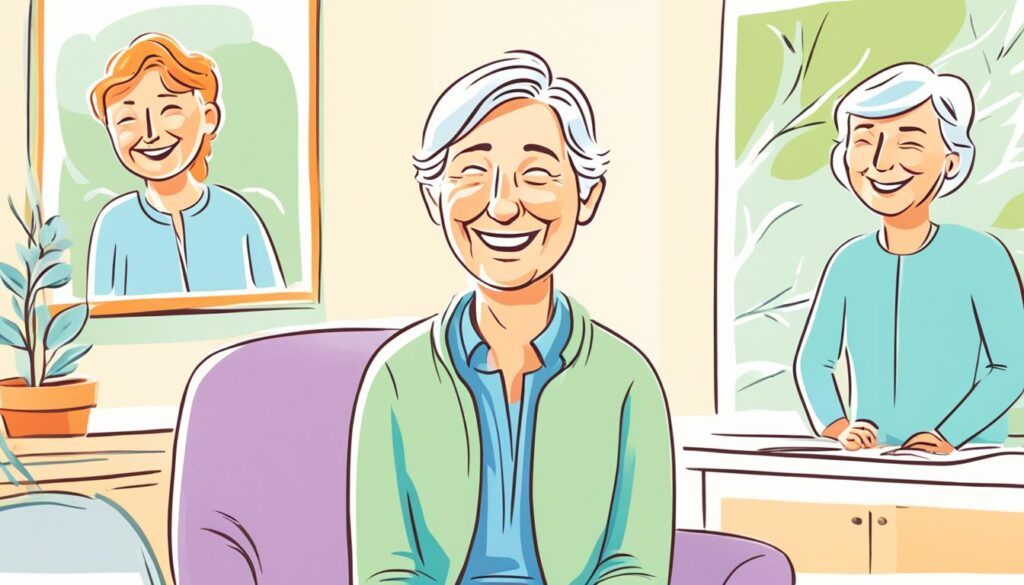
Long-Lasting Pain Management
Managing chronic pain can be tough, but treatments like radiofrequency ablation and spinal cord stimulation can help a lot. These methods target the pain source, stopping pain signals before they reach your brain. They offer relief that can last for months or even years, unlike pain meds that only help for a short time.
Radiofrequency Ablation
Radiofrequency ablation is a simple procedure that uses electrical currents to block pain signals from nerves. It aims at the pain source, giving you lasting relief for things like chronic back, neck, or joint pain.
Spinal Cord Stimulation
Spinal cord stimulation is another way to manage pain. It involves putting in a small device that sends electrical currents to the spinal cord. This helps reduce your pain significantly, giving you long-lasting pain relief.
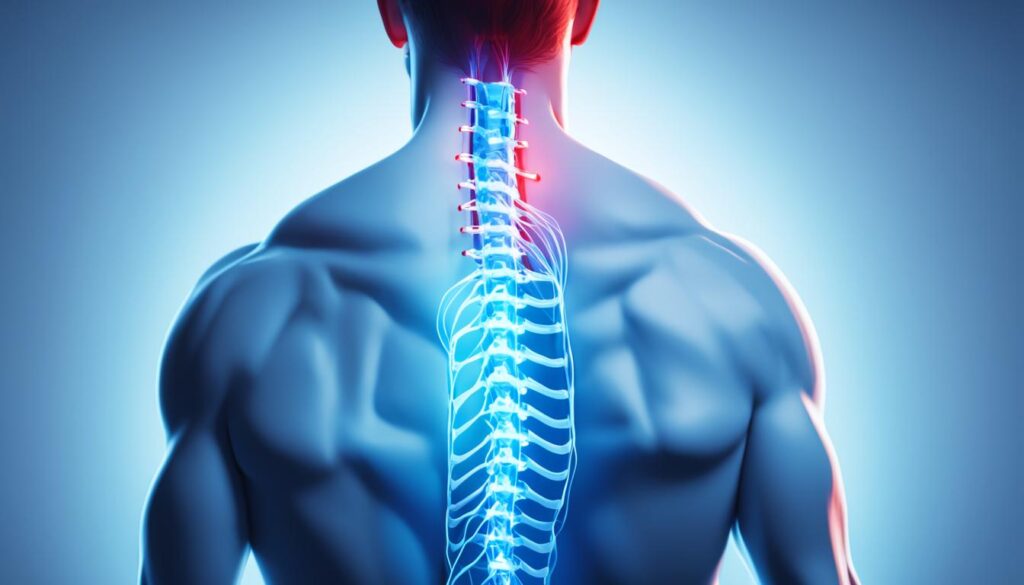
These interventional pain management methods can really change lives for people with chronic pain. They tackle the root of your pain, leading to long-term relief and a better life.
Minimally or Non-Invasive Options
Many treatments for chronic pain offer non-surgical options. These treatments can be done outside the hospital. They help pain patients find relief without major surgery and its risks.
Outpatient Procedures
Some pain management methods, like injections and nerve blocks, can be done without staying in the hospital. These minimally invasive pain treatments are done on an outpatient basis. They use advanced imaging to make sure the pain relief is accurate and effective.
Avoid Invasive Surgeries
Choosing non-invasive pain management can help avoid risky surgeries. These treatments target the pain source directly. This way, patients can find comfort without complex surgeries.
Thanks to minimally invasive pain treatments and outpatient procedures, interventional pain management is a good choice. It helps people avoid invasive surgeries and get lasting relief from chronic pain.

Interventional Pain Management Techniques
Interventional pain management uses many techniques to tackle chronic pain at its root. These methods go beyond just easing symptoms. They aim for targeted, lasting relief for those in pain.
Some top techniques include:
- Medication management, where doctors tailor medicines to fit the patient's needs for the best pain relief with fewer side effects.
- Image-guided injections, like epidural steroid injections, nerve blocks, and joint injections, which target specific pain areas.
- Physical therapy, which boosts mobility, strength, and function to lessen pain and enhance life quality.
- Minimally invasive surgeries, such as radiofrequency ablation and spinal cord stimulation, for chronic pain management.
- Regenerative medicine techniques, including stem cell therapy and platelet-rich plasma injections, which help the body heal naturally.
These techniques often work together in a personalized plan. They focus on the pain's source, not just its symptoms. This approach can lead to lasting relief and better life quality for those with chronic pain.

Fewer Side Effects
Interventional pain treatments are a better choice for chronic pain than traditional pain pills. They have fewer side effects. Pills can cause constipation, vomiting, nausea, and dizziness. But, interventional treatments are safer and easier for patients.
Chronic pain affects nearly 20% of Americans. Opioids help with pain but have many side effects. This leads to less use. Interventional pain management helps many people manage chronic pain for years with fewer side effects.
- Minimally invasive techniques in pain management can replace risky surgeries like joint replacements. This lowers the risk of side effects.
- Pain management treatments target pain at its source. This means relief without affecting the whole body or brain. So, there are fewer side effects than with traditional meds.
- These methods can cut down on the need for long-term pain meds. This reduces side effects and the risk of becoming dependent.
Choosing interventional pain treatments helps chronic pain sufferers find relief with fewer side effects. This improves their quality of life and overall well-being.
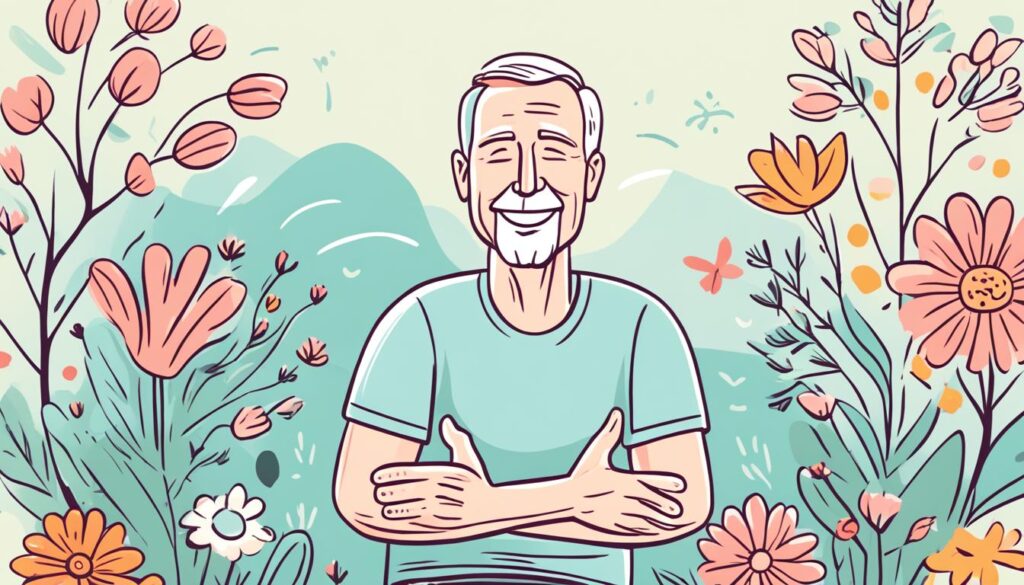
Interventional Pain Treatments
Interventional pain treatments can change the game for chronic pain sufferers. These procedures are designed to find and fix the source of pain. They offer quick and lasting relief. From epidural steroid injections for back and neck pain, to nerve blocks and joint injections, these treatments cover a wide range of chronic pain issues.
Epidural Steroid Injections
Epidural steroid injections help with lower back and neck pain. They're used for conditions like arthritis, herniated discs, or spinal stenosis. The medication goes right to the pain spot, offering targeted relief and possibly cutting down on the need for pills.
Nerve Blocks
Nerve blocks stop pain signals from reaching the brain. They're great for people with nerve pain, complex regional pain syndrome, or other nerve issues. These treatments can make a big difference for those in pain.
Joint Injections
Joint injections are a less invasive way to ease pain in knees, hips, or other joints. They help reduce inflammation and ease pain. This can be a good option instead of surgery.
If you're dealing with back, neck, or joint pain, consider interventional pain treatments. They aim to fix the underlying cause of pain. This can help you take back control of your life.
Regenerative Therapies
Interventional pain management specialists are now using regenerative therapies to help with chronic pain. These treatments work by helping the body heal itself. They focus on the root causes of pain, not just the symptoms.
Therapies like platelet-rich plasma (PRP) injections and stem cell therapy use the body's own cells to heal. PRP comes from the patient's blood and is injected into the painful area. Stem cell therapy uses cells that can turn into different types, like blood, nerve, or muscle cells.
- Regenerative therapies stimulate the body's natural healing processes to address the root causes of chronic pain.
- PRP injections utilize the patient's own platelet-rich plasma to promote tissue regeneration.
- Stem cell therapy employs the body's repair systems to regenerate damaged or diseased cells.
These treatments are great for chronic pain in joints, muscles, and discs. They help fix the underlying problems, offering lasting relief and better quality of life.
Specialists in interventional pain management create personalized treatment plans. They might include regenerative therapies and other methods. This way, they aim to give the best relief for chronic pain, cutting down on opioids and other harmful drugs.
Comprehensive Pain Management
Managing chronic pain often requires a comprehensive approach. At top interventional pain treatment centers, a team of experts works together. This team includes anesthesiologists, physical therapists, psychologists, and more.
This team creates a personalized treatment plan. It looks at the physical, emotional, and lifestyle factors that cause pain. This way, treatment is more effective and can reduce the need for surgery or opioid use.
At these centers, interventional pain treatment options like nerve ablation and targeted injections are used. These methods are safe and don't involve major surgery. They help patients find relief from chronic pain and improve their life quality.
Using a multi-disciplinary approach, these centers lead in treating chronic pain. They combine advanced therapies with teamwork. This helps patients take charge of their recovery and live better lives.
Improve Quality of Life
Chronic pain can really take a toll on someone's life. Interventional pain treatments offer hope to those in constant discomfort. These treatments target the pain's root, giving lasting relief and helping patients live fully again.
With interventional pain management, people with chronic pain see big improvements in their lives. Procedures like nerve blocks and radiofrequency ablation work directly on the pain source. This reduces pain and boosts physical function, letting patients enjoy daily activities and hobbies without pain.
- These treatments can ease pain from arthritis, nerve damage, and inflammation, making it easier to move around and stay active.
- Methods like spinal cord stimulation and intrathecal drug delivery help those with neuropathic pain or after failed back surgery.
- They can also cut down on the need for opioids, lowering the risk of addiction and side effects.
Interventional treatments give patients better control over their chronic pain. This leads to better physical health, less need for pain meds, and the chance to do more in life. The aim is to help people be more independent and live a life full of joy and activity.
The Way Forward
Understanding and treating chronic pain is changing, and interventional pain management is becoming key. It uses less invasive methods and aims to cut down on opioids. This approach offers hope for those with chronic pain.
The future of treating chronic pain is exciting, thanks to new tech and a better grasp of pain causes. Wearable devices, virtual reality therapy, and targeted treatments are changing how we handle chronic pain.
The opioid crisis is making us look for safer pain relief options. Interventional pain management is vital in this effort. It helps patients lessen their opioid use and find therapies that get to the heart of their pain.
Personalized medicine is also promising for chronic pain treatment. By using genetic tests and pharmacogenomics, doctors can make treatments that fit each patient better. This means better results and fewer side effects.
For the future, treating chronic pain will need a team effort. This means combining interventional treatments, physical therapy, support, and new therapies. Together, they can offer lasting relief to those with chronic pain.
The world of chronic pain treatment and interventional pain management is growing. With new advances and a focus on patient care, we can help people improve their lives. This leads to effective, long-lasting pain relief.
Conclusion
Interventional pain treatments offer many benefits for those with chronic pain in India. They provide targeted relief and help reduce opioid use. These treatments are quick and can last a long time, improving your life quality.
They focus on the root causes of pain and use a team approach. This makes them key in helping people with chronic pain find lasting relief.
The research shows these treatments are safe and effective. Even though there are risks, the benefits are usually greater. As research grows, we'll see more new and tailored ways to fight chronic pain.
If you have chronic pain, like complex regional pain syndrome or low back pain, consider interventional treatments. Talk to your doctor about what options you have. With the right treatment, you can manage your pain better and improve your life.
FAQ
What are the benefits of interventional pain treatments for chronic pain sufferers?
What is interventional pain treatment?
How do interventional pain treatments work?
How do interventional pain treatments reduce dependence on opioids?
How quickly can interventional pain treatments provide relief?
How long-lasting are the effects of interventional pain treatments?
Are interventional pain treatments minimally or non-invasive?
What types of interventional pain management techniques are available?
Do interventional pain treatments have fewer side effects than traditional pain medications?
What are some common interventional pain treatments?
How do regenerative therapies fit into interventional pain management?
How does the multi-disciplinary approach benefit interventional pain management?
How can interventional pain treatments improve quality of life for chronic pain sufferers?
What is the future outlook for interventional pain management?
The future looks promising for treating chronic pain with interventional methods. With a focus on minimally invasive techniques and reducing opioid use, it offers hope for those with chronic pain.
Source Links
- 6 Effective Benefits of Interventional Pain Management
- Is Pain Management Right for Me?
- Florida Medical Pain Management
- What is Interventional Pain Management?
Effective Strategies for Bulging Disc Pain Relief
Dealing with a bulging disc can be tough. But, there are ways to find relief and manage the pain. This guide will help you understand the causes and stages of disc herniation. It will also show you treatment options to take control of your pain and improve your life.
Bulging discs are common and can cause a lot of pain and limited movement. By learning about the causes and symptoms, you'll understand your situation better. This knowledge helps you find the best ways to relieve your pain.
This article covers many ways to get relief, like medicines, physical therapy, chiropractic care, and surgery. You'll see the good and bad of each method. This helps you make choices that fit your needs and likes.
It also talks about other therapies like acupuncture and changing your lifestyle. Using these together with traditional treatments can help you feel better and prevent future problems. By taking a whole approach, you can find lasting relief and avoid future issues.
Managing bulging disc pain means staying informed and working with your healthcare team. With the right strategies and a focus on your health, you can overcome this challenge. Let's look at effective strategies for bulging disc pain together.
Understanding Bulging Disc Pain
Bulging discs can cause a lot of pain and discomfort. It's key to know the causes and symptoms of this condition. Also, understanding the stages of disc herniation is important.
Causes and Symptoms of Bulging Discs
A vertebral disc is a rubbery structure that cushions the bones in the spine. If it herniates, some of the cushioning material moves out of its casing. This can put pressure on the nerves, causing pain, weakness, and numbness in the neck, back, arms, and legs.
Bulging discs often happen between the fourth and fifth lumbar vertebrae in the lower back. This is because this area bears the most weight. Things like being inactive, being overweight, smoking, and lifting incorrectly can make bulging discs more likely.
The Different Stages of Disc Herniation
Disc herniation can go through different stages, from a simple bulge to more severe conditions. In the early stages, the disc bulges a little and causes mild symptoms. But as it gets worse, the disc can rupture, and the inner material can leak out. This leads to more pain and nerve problems.
Knowing the stages of disc herniation helps with treatment. Catching it early means simpler treatments might work. But if it's more advanced, surgery might be needed.
Medications for Bulging Disc Pain Relief
Managing the pain of a bulging disc often involves using medications. Over-the-counter (OTC) pain relievers like acetaminophen, ibuprofen, or naproxen can ease moderate or mild pain and reduce swelling. But, it's key to use these for no more than 10 days. Prolonged use can raise the risk of heart issues or bleeding.
Over-the-Counter Pain Relievers
OTC pain relievers are often the first step for treating bulging disc pain. They help lessen discomfort and swelling. Some top choices are:
- Acetaminophen (e.g., Tylenol)
- Ibuprofen (e.g., Advil, Motrin)
- Naproxen (e.g., Aleve)
These medications work well, but it's vital to stick to the dosage and not take more than advised. Doing so can increase the chance of bad side effects.
Prescription Pain Medications
For more severe symptoms, doctors might prescribe stronger pain meds for a herniated disc. These can include:
- Opioid-based drugs (e.g., hydrocodone, oxycodone)
- Muscle relaxants
These meds can help with pain and muscle spasms but come with a higher risk of side effects and addiction. Doctors usually limit their use and suggest other treatments when possible.
It's crucial to work closely with a healthcare provider when looking into medications for bulging disc pain relief. They can help pick the best treatment plan for you, considering your specific needs and health history.
Physical Therapy for Bulging Disc Pain
Physical therapy is a great way to deal with the pain and mobility issues from a bulging disc. It uses stretches and exercises to ease the pressure on the disc and boost spine health.
Stretching and Strengthening Exercises
Stretching and strengthening exercises are key in fixing a bulging disc. They include moves like resting on the belly, press-up back extensions, and backward bends. These help make the spine more flexible and support the muscles around it. A therapist will create a plan that suits you and slowly increase the difficulty as you get better.
Other Physical Therapy Modalities
- Massage therapy: Gentle massage helps reduce muscle tension and promotes relaxation, which is good for those with bulging disc pain.
- Ice and heat therapy: Using ice or heat on the area can help with inflammation and ease pain.
- Ultrasound: This uses sound waves to improve blood flow and lessen muscle spasms deep in the tissues.
- Electrical muscle stimulation: This method uses electrical currents to help reduce pain and enhance muscle function.
A full physical therapy program with these methods is vital for managing bulging disc pain. It helps people get their mobility back and improves their life quality.
Chiropractic Care for Bulging Discs
If you're dealing with pain from a bulging disc, think about chiropractic care. Studies suggest it's a good choice for those who haven't gotten better with other treatments. This includes pain relievers, lifestyle changes, physical therapy, and more.
Chiropractors use special techniques like spinal manipulation and flexion-distraction. These methods can ease the pain of bulging discs. They help reduce nerve pressure, improve movement, and aid healing. This might mean you can avoid surgery.
- Spinal manipulation is a key part of chiropractic care. It helps align the spine and lessens disc pressure, easing pain and symptoms.
- Flexion-distraction stretches and decompresses the spine. It's a painless way to move the disc away from the nerve.
- Pelvic blocking helps realign bulging discs and reduces nerve pressure.
Chiropractors might also suggest physical therapy, massage, and other therapies. These help with healing and keeping the spine healthy. By focusing on your whole health, chiropractors can help you manage your pain and might prevent surgery.

Remember, chiropractic care works well for many people, but it depends on your symptoms. If it doesn't help, your chiropractor might suggest seeing a pain specialist or surgeon for more options.
Acupuncture as a Complementary Therapy
If you're dealing with the pain of a bulging disc, acupuncture might help. It's a traditional Chinese medicine that can ease neck and lower back pain. Many people find it effective for managing disc bulge symptoms.
Acupuncture for disc pain usually means going to the acupuncturist once or twice a week for six to eight sessions. Each session involves putting about 20 needles in specific spots on your body. These needles stay in for 10 to 15 minutes to help reduce pain and support healing.
Not everyone finds acupuncture helpful for disc pain. The success depends on how severe the bulge is and your overall health. Being overweight can also affect how well acupuncture works, as it puts extra strain on your spine.
If you're thinking about trying acupuncture for your pain, find a skilled acupuncturist. They'll create a plan just for you. Using acupuncture with other treatments like physical therapy and chiropractic care might help you feel better and live better.

Steroid Injections for Bulging Disc Pain Relief
If you're dealing with a bulging disc, steroid injections might help. Epidural injections put steroid medicine near the spinal nerve. This can lessen inflammation and ease pain. Studies show these injections work well for lower back and leg pain from disc herniations.
Nerve root injections target the nerve hit by the disc bulge. They can ease symptoms, giving you relief.
Lumbar epidural steroid injections are a common way to treat radicular pain. In the U.S., back pain is a top reason people visit doctors. About 9% to 25% of people have low back pain that spreads to their legs, known as radicular pain, every year.
You can get epidural steroid injections up to three to six times a year. They can last three to six months or more for chronic pain or recurring disc issues. Some side effects include pain at the injection site or temporary pain increase. But, the risks like bleeding, infection, and nerve damage are low if done right by skilled doctors.
Thinking about steroid injections for your disc pain? Talk to your healthcare team to find the best treatment for you. With the right treatment, you can improve your life and enjoy activities again.
Surgical Options for Bulging Discs
Some people with bulging discs need surgery if their symptoms don't get better or get worse. Two common surgeries are microdiscectomy and laminotomy with spinal fusion.
Microdiscectomy
Microdiscectomy is a simple surgery that removes the part of the disc pressing on the nerves. It's for people whose leg pain is worse than their back pain and have a big disc herniation. Recovery is quick, and most can go back to normal activities in days.
Laminotomy and Spinal Fusion
For severe cases, a laminotomy or spinal fusion might be needed. These procedures help stabilize the spine and ease pain. They're for people with spine instability or big disc herniations causing a lot of pain. Recovery takes longer, but these surgeries can help for a long time.
Choosing to have disc herniation surgery, microdiscectomy, or spinal fusion for bulging discs should be talked over with a spine specialist. They can look at your situation and suggest the best treatment.

Lifestyle Modifications for Pain Management
Alongside medical treatments, making lifestyle changes can help manage bulging disc pain. Keeping a good posture and using body mechanics wisely, like squatting to lift, can prevent spine strain. It's also key to stay at a healthy weight to avoid making disc problems worse.
Also, quitting smoking is vital for managing disc pain. Smoking can make disc degeneration worse and make existing problems worse. By changing your lifestyle this way, you can help your other treatments work better and prevent more disc issues.
Proper Posture and Body Mechanics
- Keep a good posture when sitting, standing, or walking to ease spine strain.
- Use the right lifting techniques, like squatting, to avoid hurting your discs.
- Do stretching and strengthening exercises regularly to make your core and back muscles stronger.
Weight Management and Smoking Cessation
- Keep a healthy weight with a balanced diet and regular exercise to ease the load on your discs.
- Quit smoking to stop the harm from nicotine and boost your disc health.
- Get help from health experts or join a program to help you quit smoking.
By changing your lifestyle, you can help manage your bulging disc pain and support your spinal health over time. Remember, using both medical treatments and lifestyle changes is often the best way to find lasting relief.
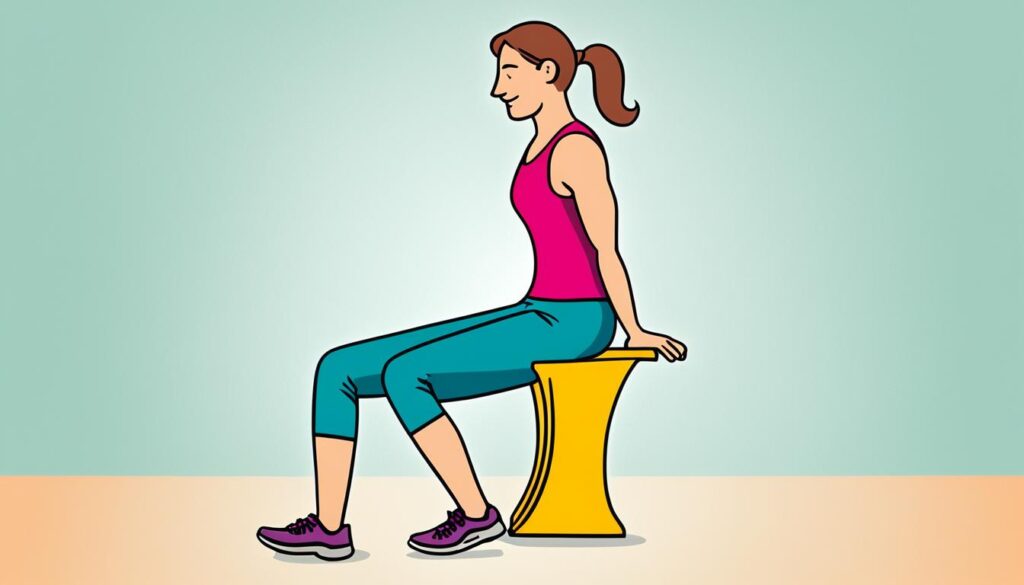
Bulging disc pain relief
Dealing with a bulging disc can be tough, but surgery isn't always the first step. Many people find relief without surgery by trying non-surgical treatments. These include medicines, physical therapy, chiropractic care, and changing your lifestyle. Each option can help ease your pain and make life better.
Understanding the different stages of disc herniation is key to finding the right treatment. Trying various therapies can help you find what works best for you. This approach can help you avoid surgery and give you lasting relief.
Leveraging a Variety of Non-Surgical Treatments
Your doctor might suggest several non-surgical treatments for your bulging disc, depending on its severity:
- Over-the-counter pain relievers, such as acetaminophen, ibuprofen, or naproxen, to reduce inflammation and manage mild-to-moderate discomfort.
- Prescription medications, including muscle relaxants, anti-inflammatory drugs, or nerve pain medications, for more severe cases.
- Physical therapy exercises and techniques, such as stretching, strengthening, and manual therapies, to improve mobility and stability.
- Chiropractic adjustments and spinal manipulation to help alleviate pressure on the affected disc.
- Acupuncture and other complementary therapies that may provide additional pain relief and promote healing.
- Lifestyle modifications, including weight management, proper posture, and avoiding activities that exacerbate your symptoms.
Trying these non-surgical options can help you find the best treatment for you. You can avoid the risks and recovery time of surgery this way.
The main goal is to manage your bulging disc pain without surgery and improve your life. With patience and trying different therapies, you can often find relief without surgery.
Alternative Therapies for Disc Bulges
Traditional medical treatments can help with bulging disc pain. But, some people find relief with alternative therapies. Inversion table therapy and an anti-inflammatory diet are two options to consider.
Inversion Table Therapy
Inversion table therapy flips your body upside down to ease spine pressure. It's known to ease symptoms of [https://aica.com/how-to-heal-a-bulging-disc-naturally/]bulging discs. By easing gravity's pressure, these tables might help decompress the disc and let nutrients flow back in.
Anti-Inflammatory Diet
Along with physical treatments, an [https://aica.com/how-to-heal-a-bulging-disc-naturally/]anti-inflammatory diet can help. This diet includes foods that fight inflammation, like:
- Leafy greens
- Fatty fish
- Turmeric
- Ginger
- Berries
It targets inflammation that can cause bulging disc pain. This diet can help heal and manage pain naturally.
Remember, while these therapies can be helpful, talk to a healthcare expert. They can guide you to the best treatment for your needs.
Preventing Future Disc Bulges
Keeping your spine healthy is key to avoiding future disc bulges. While treatments can help manage bulging discs, prevention is better. By making smart lifestyle choices and strengthening your spine, you can lower the risk of disc problems.
Good posture is a top way to prevent disc bulges. Keeping your spine in line while sitting, standing, or doing daily tasks reduces stress on your discs. Doing core exercises helps build a strong spine support system.
It's also important to keep a healthy weight to prevent disc bulges. Being overweight puts extra pressure on your spine, which can lead to disc problems. Eat well and exercise regularly to keep your weight in check and ease the strain on your spine.
- Quit smoking, as it can cause disc degeneration and weaken your spine.
- Try low-impact exercises like swimming, cycling, and gentle yoga to keep your back muscles strong and flexible.
- Use proper lifting techniques, avoid heavy lifting, and take breaks to prevent strain on your discs.
By focusing on these steps, you can help keep your spine healthy and reduce the chance of future disc bulges. Taking care of your spine now can help you stay mobile and healthy for the long run.
When to Seek Medical Attention
If you're feeling the pain of a bulging disc, knowing when to get help is key. Most bulging disc pain gets better with treatment in 4 to 6 weeks. But, some signs mean you should see a doctor right away.
One important sign is worsening leg pain or weakness. This could mean nerve compression or spinal cord damage. Also, losing control of bowel or bladder, or big neurological problems, means you should get help fast.
Other signs of a serious herniation include severe, ongoing pain that doesn't go away with rest or meds. Pain that goes down the leg, especially below the knee, is another warning. These might need spinal injections or surgery to fix and prevent more problems.
If you're not sure if you should see a doctor, it's best to be safe. Getting medical help quickly can make sure you get the right treatment. This helps you recover faster.
Your health is the most important thing. Don't wait to talk to your doctor if you're worried about your bulging disc or spine issues.
Combining Therapies for Comprehensive Care
Managing bulging disc pain often requires a mix of treatments. This approach helps tackle different parts of your condition. It includes using medications, physical therapy, chiropractic care, and other treatments that fit your needs and likes.
You might start with over-the-counter pain relievers for the first step. Then, you could do stretching and strengthening exercises as suggested by a physical therapist. Chiropractic adjustments can also help fix your spine alignment. Plus, therapies like acupuncture or eating less inflammatory foods might help ease your pain.
Using these different methods together can help fix the main causes of your pain. This way, your body can heal naturally. Such a mix of treatments can be very effective in giving you lasting relief and making your life better.
It's important to work with your healthcare team to make a plan that suits you. Don't be afraid to try different therapies to find what works best. With a detailed, combined approach, you can manage your bulging disc pain and live an active, pain-free life.
Conclusion
Dealing with a bulging disc can be tough, but you have many ways to find relief. You can try medications, physical therapy, chiropractic care, steroid injections, and surgery. Work with your healthcare team to find what works best for you.
Adding lifestyle changes can also help. This means keeping good posture, managing your weight, and quitting smoking. Trying inversion table therapy and anti-inflammatory diets can also boost your recovery and prevent future problems. A mix of treatments can help you manage your pain and improve your life.
You don't have to go through this alone. The team at Surf & Sports Myo can guide you through non-surgical options. They can help you create a plan to ease your pain. Start on the path to a pain-free life by looking into these options today.
FAQ
What are the common causes and symptoms of bulging discs?
How can medications help manage the symptoms of a bulging disc?
What role does physical therapy play in the management of bulging disc pain?
How can chiropractic care help with bulging disc pain?
Can acupuncture be used as a complementary therapy for bulging disc pain?
When are steroid injections used to treat bulging disc pain?
What surgical options are available for treating severe bulging disc pain?
How can lifestyle modifications help manage bulging disc pain?
What alternative therapies can be used to address bulging disc pain?
When should you seek medical attention for bulging disc pain?
See a doctor if the pain doesn't go away or gets worse, or if you have serious symptoms like worsening leg pain, weakness, loss of bowel or bladder control, or neurological problems. Quick action can prevent further issues and ensure the right treatment.
Source Links
- Managing Disc Bulge: Effective Strategies for Pain Relief
- 6 Tips for Relieving Pain From Herniated Discs - Achieve Therapy
- Securing Effective L3-L4 Treatment for Bulging Disc and Lower Back Pain Relief | NJ Spine & Orthopedic
Comprehensive Guide to Slipped Disc Pain Relief
If you're feeling the pain of a slipped disc, you're not alone. Many people suffer from slipped discs, which can really affect your life. Luckily, there are many ways to ease the pain and get you moving again.
This guide covers both non-surgical and surgical treatments for slipped disc pain. You'll learn about medicines, physical therapy, epidural injections, and how to take care of yourself. We'll also talk about how to prevent future problems and when to see a doctor. This guide aims to give you the knowledge and tools to manage your back pain and find lasting relief.
Not all slipped discs cause pain, and most back pain isn't serious. With the right treatment and a proactive approach, you can beat the pain of a slipped disc. You can get back to living an active, pain-free life.
Understanding Slipped Discs
A slipped disc, also known as a herniated or prolapsed disc, is a common spinal issue. It happens when the rubbery cushion between the spine's vertebrae bulges or ruptures. This can put pressure on the nerves, leading to pain, numbness, and weakness. Knowing what causes slipped discs helps with prevention and management.
What is a Slipped Disc?
The spine has vertebrae, and between each one is a disc that absorbs shock. These discs have a tough outer layer and a soft, gel-like core. When a disc herniates or slips, the inner core comes out through the outer layer. This puts pressure on the nerves and causes symptoms.
Causes of Slipped Discs
Several factors can lead to a slipped disc, including:
- Age: As we get older, our spine's discs lose water and become more likely to slip or herniate.
- Injury: Trauma, like a car accident or a fall, can cause a disc to rupture or bulge.
- Poor posture and improper lifting techniques: Stress on the spine from bad posture or lifting wrong can lead to disc herniation.
- Degenerative disc disease: This is when the discs wear out over time, making slipping more likely.
Knowing what causes slipped discs is key to preventing and managing them. By addressing these factors, people can lower their risk of this painful condition.
Symptoms of a Slipped Disc
If you have a slipped disc, you might notice symptoms that affect your daily life. Common signs include back pain, leg pain (sciatica), muscle weakness, and numbness or tingling in the affected limb.
The symptoms depend on where the slipped disc is and how much it presses on nerves. For example, a slipped disc in the lower back might cause radiating leg pain, muscle weakness, and numbness or tingling in your legs and feet. A slipped disc in the neck could lead to neck pain, shoulder pain, and tingling or weakness in your arms and hands.
Some people might have a herniated disc without noticing it at. But as it gets worse, symptoms can become more severe, making it hard to move and enjoy life.

If you're feeling any of these slipped disc symptoms, sciatica pain, radiating leg pain, muscle weakness, numbness and tingling, see a doctor right away. Working with a healthcare professional can help ease your pain and stop it from getting worse.
Importance of Rest and Activity Balance
Finding the right balance between rest and activity is key when you have a slipped disc. Bed rest can help at first, but too much rest can make muscles stiff and weak. On the other hand, doing too much too soon can make things worse.
Why Rest is Crucial
Rest is vital in the early stages of a slipped disc. It lets the body heal and reduces swelling. This helps the disc move back into place. If you push yourself too hard, you might take longer to recover or even make things worse.
Staying Active for Recovery
When the pain goes down, start moving gently and do low-impact exercises. These keep muscles from getting too small and help blood flow better. Doing things like low-impact exercises and gentle stretches is good. Just make sure you don't do too much to avoid needing more rest.
Moving around is very important when you're getting better. The right mix of rest and activity helps you heal faster and get back to normal sooner.

Medications for Slipped Disc Pain Relief
Managing pain from a slipped disc often involves using medications. Over-the-counter (OTC) anti-inflammatory drugs like acetaminophen, ibuprofen, and naproxen can ease inflammation and discomfort.
Over-the-Counter Pain Relievers
OTC anti-inflammatory drugs are good for treating slipped disc pain. They should not be taken for more than 10 days without a doctor's advice. This is because they can raise the risk of heart issues or bleeding inside the body.
Prescription Medications
If the pain is severe, your doctor might prescribe stronger drugs. These could be opioid pain relievers, muscle relaxants, or medications for nerve pain. While these can help, they come with more side effects and should be used with a doctor's watchful eye.
Always follow your doctor's advice when taking any medication for a slipped disc. Using a mix of medications, physical therapy, and lifestyle changes can give you the best relief.

Physical Therapy and Exercises
If you're struggling with a herniated disc, physical therapy can really help. A skilled therapist will create a plan just for you. This plan includes stretching, strengthening exercises, and spinal decompression techniques.
Benefits of Physical Therapy
Physical therapy is great for treating herniated discs. Your therapist will focus on the exact area that hurts. They'll use exercises and stretches to make you more flexible and strong.
This is key for supporting your spine and preventing future problems.
Herniated Disc Exercises
Doing certain exercises can really help with herniated disc pain. Press-ups, backward bends, and core exercises can ease the pressure on the disc. For neck pain, try moving your chin towards your chest and side-to-side ear movements.
Hamstring stretches can also help if your disc is in the lower back or legs. But always listen to your body. If an exercise hurts, stop doing it.
Your physical therapist will guide you through a safe program. They'll help you recover from your herniated disc.
Epidural Steroid Injections
If other treatments don't help, your doctor might suggest an epidural steroid injection. This method involves putting a corticosteroid medication near the spinal nerves. It aims to lessen inflammation and pain. Epidural injections can offer temporary relief and help you do physical therapy better.
These injections can be given up to three to six times a year. They're meant to last three to six months or longer. But, there are some risks like bleeding, infection, and nerve damage. These risks are very low if a skilled healthcare professional does the injection.
Side effects of epidural steroid injections can include mild pain at the injection site, temporary increase in usual pain, flushing, trouble sleeping, higher blood sugar, and headaches. These shots are usually given by pain management doctors, physiatrists, and interventional radiologists. The Hospital for Special Surgery, ranked No. 1 in orthopedics for 14 years, is one place where they're given.
There are changes in how epidural steroid injections are used before spine surgery. Lumbar epidural steroid injections are often used for radicular pain. This type of pain affects about 9% to 25% of people every year.

Slipped Disc Pain Relief
If you're feeling the pain of a slipped disc, there are natural ways to help. You can try hot or cold therapy, or even gentle massage. These methods can ease your symptoms and help you heal.
One easy way to ease slipped disc pain is with hot and cold therapy. An ice pack can reduce swelling and numb the pain. A heating pad can relax muscles and boost blood flow. Switching between hot and cold can give you more relief.
Massage therapy is another great option for slipped disc pain. It can relax muscles, improve blood flow, and ease tension. Make sure to see a licensed massage therapist for the best results.
Other ways to help with slipped disc pain include:
- Acupuncture: This ancient Chinese practice can help stimulate the body's natural pain-relieving mechanisms and promote healing.
- Chiropractic care: A chiropractor can perform spinal adjustments and other techniques to help realign the spine and reduce pressure on the affected disc.
- Yoga and stretching: Gentle, low-impact exercises can help improve flexibility, strengthen the core, and reduce stress on the spine.
Always talk to your healthcare provider before trying new remedies or treatments. They can give you advice that fits your needs and ensures safety.

Surgical Options for Severe Cases
Some slipped discs need surgery, especially if other treatments don't work. Surgery options include discectomy, spinal fusion, and artificial disc replacement. These are chosen when other treatments don't help enough.
Discectomy
Discectomy removes the damaged part of the disc. This herniated disc surgery takes pressure off the nerve and reduces pain. It's a minimally invasive procedure with a low risk of complications.
Spinal Fusion
Spinal fusion might be needed to stabilize the spine. It fuses two or more vertebrae together. This prevents further disc problems and eases pain. Recovery from spinal fusion takes longer than from discectomy.
Artificial Disc Replacement
For some, artificial disc replacement is an option. It replaces the damaged disc with an artificial one, keeping the spine's natural movement. This surgery is less invasive than spinal fusion.
The right surgery depends on your slipped disc's severity and your health and lifestyle. Always talk to a spine specialist to find the best treatment for you.

Self-Care Tips for Herniated Discs
Keeping a good posture and lifting safely are key to avoiding and handling slipped discs. By adding these habits to your daily life, you can lower the chance of future problems and ease current pain.
Proper Posture
Having a straight spine is vital for your discs. Always be aware of your posture when sitting, standing, or doing activities. Keep your shoulders back, head up, and weight evenly spread. Don't slouch or hunch, as it can harm your back.
Lifting Techniques
Use your legs, not your back, when lifting heavy things. Bend at the knees and keep your back straight. Lift the item close to your body. Don't twist your body, as it can cause a slipped disc. For more slipped disc prevention, use ergonomic habits and safe lifting at work and home.
Focus on activities that are good for your back to manage and prevent herniated disc pain. Talk to a healthcare expert for advice on keeping your spine healthy and avoiding future problems.
Preventing Future Slipped Discs
To avoid getting a slipped disc, focus on keeping a healthy weight and stop smoking. Being overweight and smoking can make disc problems worse. By changing your lifestyle, exercising, and keeping good posture, you can protect your spine.
Maintain a Healthy Weight
Keeping a healthy weight helps lessen the stress on your spinal discs. Too much weight, especially around your belly, puts more pressure on your spine. This can lead to disc problems. Use diet and exercise to manage your weight and prevent slipped discs.
Quit Smoking
Smoking is a big risk for needing more surgery for disc problems. Quitting smoking helps your spine by improving blood flow, reducing inflammation, and keeping tissues healthy. This can lower your risk of getting a slipped disc or having it happen again.
Along with a healthy weight and quitting smoking, regular exercise, proper lifting, and good posture help prevent slipped discs. These changes can protect your spine and lower the risk of pain and disability from a slipped disc.
When to Seek Medical Attention
If you have a slipped disc, it's important to see a doctor quickly if things get worse. Look out for signs like muscle weakness, trouble with your bowels or bladder, or pain that's really bad. These could mean you need urgent care to avoid nerve damage or other serious problems.
A 2011 study found that waiting over six months to see a doctor about a herniated disc didn't help much. In fact, waiting too long can cause more harm than good. So, it's best to get medical help right away for a herniated disc.
Here are signs you should see a doctor or a spine specialist:
- Worsening or severe pain that doesn't improve with rest
- Significant muscle weakness or loss of sensation in your legs or feet
- Difficulty controlling your bladder or bowels
- Balance issues or difficulty walking
Getting a diagnosis and treatment quickly is key for dealing with herniated disc issues. Your doctor might use scans like CT or MRI to figure out what's causing your pain. Then, they can suggest the best treatment, which could be medical care or surgery, as explained in this article.
Don't hesitate to get medical help if you're showing severe symptoms or if your condition is getting worse. Acting fast can prevent nerve damage and help you recover better.
Conclusion
Managing slipped disc pain requires a full approach that includes rest, medicine, physical therapy, and sometimes surgery. By knowing the causes, symptoms, and treatment options, you can help yourself recover and avoid future problems.
Working with your healthcare team is key to managing a slipped disc. They can help create a plan that fits your needs. This plan might include over-the-counter pain relievers, exercises, making changes to your work setup, and finding ways to reduce stress. These steps can help you live without pain and stay active.
Learning about your condition and taking an active part in your care can greatly improve your recovery. With the right mix of rest, therapy, and prevention, you can beat the challenges of a slipped disc. This will help you get back to feeling good overall.
FAQ
What is a slipped disc?
What are the common causes of slipped discs?
What are the main symptoms of a slipped disc?
Why is it important to find the right balance between rest and activity?
What types of medications can help alleviate slipped disc pain?
How can physical therapy help with slipped disc treatment?
What is the purpose of epidural steroid injections for slipped discs?
What are some self-care strategies for slipped disc pain relief?
When is surgery considered for slipped discs?
How can you prevent future slipped discs?
When should you seek medical attention for a slipped disc?
See a doctor if your symptoms get worse, you have severe pain, muscle weakness, or trouble controlling your bowels or bladder. These could mean a serious issue that needs quick medical help.
Source Links
- The Ultimate Guide to Slipped Disc Treatment - Delhi Pain Management Centre
- Slipped (Herniated) Disc: Symptoms, Causes, and Effects
- Slipped Disc: Exercises for Pain Relief
- 6 Things to Know about Slipped Discs in the Lower Back
- Slip disc treatment at home | Dr. Amit Sharma
- Slip Disc: Exploring Types, Risk Factors, and Progressive Treatment
- Slipped Disc Exercises for Pain Relief and Treatment | Metropolis TruHealth
7 Tips for Instant Back Pain Relief: Quick and Easy Solutions
Have you ever felt a sudden sharp ache in your back while getting out of bed or sitting at your desk? You're not alone. Back pain can come without warning and leave you struggling to move. But what if you could get instant back pain relief right at home using safe, simple methods?
In this blog, we will walk you through 7 easy tips to help you find instant back pain relief. Whether you're dealing with tight muscles, poor posture, or long sitting hours, these solutions are fast, practical, and need no special tools.
What Are the Most Common Causes of Sudden Back Pain?
Many people experience back pain due to small, everyday mistakes. These problems build up over time and lead to discomfort. Knowing the common causes can help you fix them fast.
Most back pain happens because of simple habits like:
- Sitting for long hours without moving
- Lifting heavy objects the wrong way
- Sleeping on a soft mattress
- Weak abdominal or back muscles
- Bending over while using your phone or laptop
Imagine you're working from home. You're slouched on your sofa, typing away on your laptop. You get up after two hours, and boom, your lower back starts to hurt. This happens to many people with desk jobs.
Stat to Know:
"Over 80% of adults experience back pain at some point, often due to lifestyle and mechanical causes." — CDC
That's 4 out of every 5 people!
Read: Home Remedies for Knee Pain: Natural Relief for Joint Discomfort
Can Stretching Really Offer Instant Back Pain Relief?
Yes, it can. Light stretches can ease muscle tightness, improve blood flow, and offer instant back pain relief within minutes.
Here are 3 easy stretches you can try:
Cat-Cow Stretch
- Start on your hands and knees
- Inhale, drop your belly, lift your head (cow position)
- Exhale, arch your back and tuck your chin (cat position)
- Repeat for 10–12 times
This improves flexibility and takes pressure off the spine.
Knee-to-Chest Stretch
- Lie on your back
- Pull one knee toward your chest
- Hold for 20 seconds
- Repeat with the other leg
It relaxes the lower back muscles quickly.

Child's Pose
- Kneel on the floor, sit back on your heels
- Stretch your arms forward and drop your head
- Hold for 30 seconds
This is one of the best stretching exercises for pain in your lower back.
How Effective Are Heat and Cold Packs for Quick Back Pain Relief?
Using heat or cold can offer instant back pain relief if done correctly. The trick is to know when to use what.
| Situation | Use Heat or Cold | How It Helps |
|---|---|---|
| Sudden injury (1-2 days) | Cold | Reduces swelling and numbs pain |
| Chronic tension or stiffness | Heat | Relaxes tight muscles and boosts blood flow |
Research Insight:
"A study in the Journal of Clinical Rehabilitation found heat wraps reduced lower back pain intensity by 47% within 2 hours."
You can try:
- Hot water bag
- Heating pad
- Ice pack wrapped in a towel
Reminder: Don’t use them for more than 20 minutes at a time.
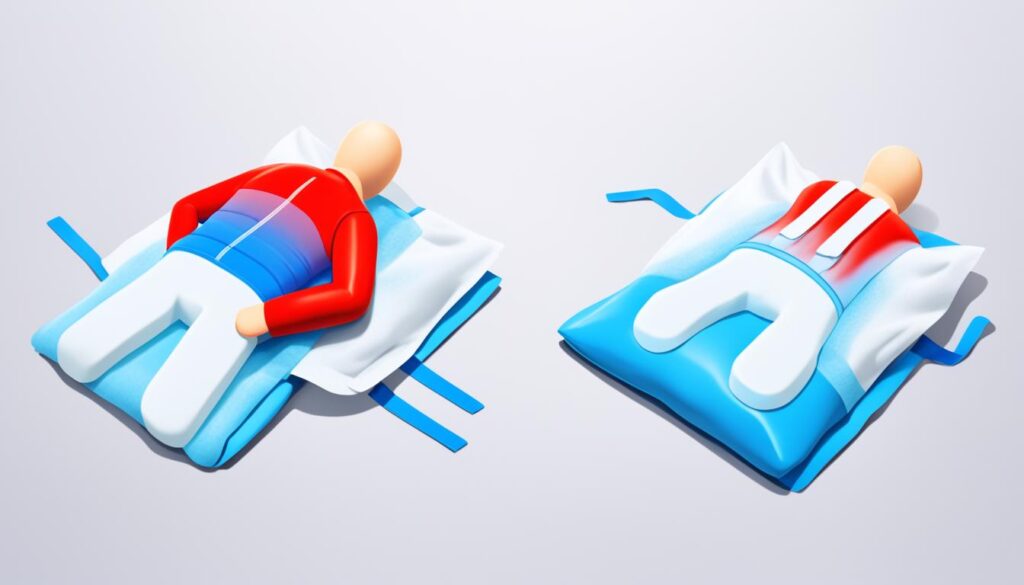
Back Stretches and Yoga Poses
Dealing with back pain can be tough, but good news is simple stretches and yoga poses can help. These exercises target muscles and joints around the spine. They improve flexibility, reduce muscle tension, and help with spinal alignment. This can ease your back pain.
Simple Stretches for Back Pain Relief
The knee-to-chest stretch is easy and very helpful. Lie on your back and pull one knee towards your chest. Hold for 30 seconds, then switch sides. It helps ease tension in the lower back and hips.
The cat-cow pose is another good choice. Start on your hands and knees. Arch your back and look up for the cow pose, then round your spine and tuck your chin for the cat pose. Do this 10-15 times to loosen your back.
The pelvic tilt is simple yet effective. Lie on your back with knees bent and feet flat. Tilt your pelvis up, pressing your lower back into the floor, then release. Do 10-15 reps to help your core and ease lower back pain.

Adding these stretches to your daily routine can greatly help with back pain. Always listen to your body and don't push too hard. The goal is to do the exercises gently and regularly.
Can Good Posture Fix Back Pain Instantly?
Yes. Sometimes, just standing or sitting properly can bring instant back pain relief.
Quick Mirror Test:
Stand in front of a mirror. Is one shoulder higher than the other? Is your head tilted forward? These are signs of poor posture.
Wall Test:
- Stand with your back against a wall
- Heels, buttocks, shoulders, and head should touch the wall
- This is your ideal posture
Correct Posture Tips:
- While sitting: Keep feet flat, back straight, and monitor at eye level
- While standing: Weight balanced on both feet, avoid leaning
Bad posture can lead to spinal strain. Follow posture correction tips daily to avoid it.
Pain Relief Creams and Ointments
For those with ongoing back pain, over-the-counter creams and ointments can offer quick relief. These topical treatments are easy to use and target specific pain spots. They can be a key part of managing back pain.
Topical Creams for Back Pain
Creams with menthol can cool and numb the area, easing pain. Those with CBD may also help by reducing inflammation.
Choosing the right pain relief cream is easy with so many options in India. You can pick from Diclofenac Diethylamine, Linseed Oil, Menthol & Methyl Salicylate Gel, or Pain Killer Tablets. Each has its own rating and price, making it easy to find what works for you.
Using these creams with other treatments like exercise and heat or cold therapy can help more. Adding pain relief creams to your daily routine might just bring the relief you've been looking for.

Massage Therapy
If you're dealing with back pain, massage therapy might help. It can relax tight muscles, boost blood flow, and ease discomfort. Techniques like kneading, friction, and gliding focus on sore spots with soft tissue massage.
Studies are still looking into how well massage works for long-term back pain. Yet, many people find it helpful when used with other treatments. A 2011 study in the Annals of Internal Medicine showed massage helped people with chronic back pain for six months.
Back pain can come from many things, like falls, heavy lifting, bad posture, or sitting too much. Issues like bulged or broken discs, arthritis, and osteoporosis can also cause pain. If your back pain doesn't go away or is very bad, see a doctor to find out why and get a full treatment plan.
Massage therapy is a great option for back pain relief. It targets sore areas and helps you relax. Massage therapy for back pain can make a big difference in how you feel overall.

Herbal Remedies for Back Pain
If you're looking for natural ways to ease back pain, consider herbal remedies. Plants like turmeric, ginger, and devil's claw have anti-inflammatory properties. These can help reduce pain. Always talk to a healthcare professional before adding them to your treatment plan, especially if you're on other medications.
Natural Herbs for Back Pain Relief
Turmeric comes from the Curcuma longa plant and is known for its anti-inflammatory compounds. These compounds, called curcuminoids, may help lessen back pain. Ginger is another herb that can reduce inflammation and ease back pain.
Devil's claw, from Southern Africa, is used to help with back pain. It has compounds like harpagoside that can lessen inflammation and ease muscle and joint pain.
While these herbs look promising, always talk to your healthcare provider before trying them. They might interact with your medications or have side effects. Adding natural herbs to your back pain care could be a good, holistic choice.

Proper Posture and Ergonomics
Good posture and ergonomic furniture are key to avoiding back pain. Using the right sitting, standing, and lifting methods can ease back muscle and spine strain. It's crucial to pay attention to your posture and adjust your workspace and daily habits to support your back health.
Sitting for long periods can cause back pain by putting stress on your back, neck, arms, and legs. This can also put pressure on your back muscles and spinal discs. Over time, poor sitting posture and ergonomics can damage your spinal structures, leading to neck or back pain.
Maintaining Proper Sitting Posture
- Ensure your upper arms are parallel to your spine.
- Be able to easily slide your fingers under your thigh at the chair's edge.
- Adjust the chair's depth to provide calf support.
- Maintain lower back support to minimize strain.
- Position your computer screen at eye level.
- Adjust armrests to slightly lift your arms at the shoulders.
Active seating options like Swedish kneeling chairs or Swiss exercise balls can help keep you upright and strengthen muscles. Remember, chairs with good lumbar support are crucial for keeping your spine naturally curved and easing lower back strain.
Improving Standing and Lifting Techniques
Standing correctly, with your ears, shoulders, and hips in line, can ease strain and support your spine. Always bend your knees when lifting to keep your posture right and lower injury risk.
Doing exercises like shoulder rolls and chest stretches can strengthen muscles that support your spine. Switching between sitting and standing at work can also help maintain better posture and improve your overall health.
By focusing on proper posture and ergonomics, you can effectively prevent and manage back pain. This ensures your body stays well-supported all day.
Getting Quality Sleep
Getting good sleep is key when you have back pain. Studies show that bad sleep can make back pain worse. It's important for your body to heal and muscles to recover.
To help your sleep and ease back pain, try these tips:
- Use supportive pillows: Choose pillows that keep your spine straight and support your head, neck, and shoulders. [1]
- Avoid sleeping on your stomach: Stomach sleeping can strain your back and neck. Try sleeping on your side or back instead. [1]
- Keep a regular sleep schedule: Stick to a routine to help your body's natural sleep cycle. [1]
- Fix sleep problems: If you often have trouble sleeping, like sleep apnea or insomnia, see a doctor. [1]
Using these tips and focusing on good sleep can help manage your back pain. A rested body can heal and recover better from back issues.
Anti-Inflammatory Diet
If you're dealing with back pain, trying an anti-inflammatory diet might help. This diet focuses on foods that lessen inflammation. It can help ease your pain and support your spine's health.
Foods to Include
- Whole grains like brown rice, quinoa, and whole wheat bread, which are rich in fiber and nutrients that can help reduce inflammation.
- Dairy products such as yogurt, milk, and cheese, which are excellent sources of calcium and vitamin D, essential for strong bones and preventing back issues.
- Fruits and vegetables, especially those that are deeply colored, as they are high in antioxidants and anti-inflammatory compounds.
- Fatty fish like tuna, salmon, and sardines, which are rich in omega-3 fatty acids that can help reduce inflammation.
- Nuts and seeds, such as almonds, walnuts, and flax seeds, which are also high in anti-inflammatory omega-3s.
- Turmeric and ginger, which contain compounds like curcumin that are known for their potent anti-inflammatory properties.
Adding these anti-inflammatory foods to your meals can help control inflammation. This can lessen your back pain.
Foods to Avoid
It's also key to eat fewer foods that can cause inflammation. These include foods high in added sugars, unhealthy fats, and processed carbs. Examples are:
- Processed foods and baked goods with trans fats and saturated fats
- Refined carbohydrates like white bread, pasta, and sugary snacks
- Alcohol, which can cause dehydration and hinder the absorption of essential nutrients
By eating fewer of these foods and more anti-inflammatory ones, you can help manage your back pain. This supports your spine's health.
Stress Management Techniques
Stress can make back pain worse. Adding stress management to your treatment plan can really help. Techniques like mindfulness meditation, deep breathing, progressive muscle relaxation, and guided imagery can ease tension. They help with both the mind and body aspects of back pain.
Mindfulness and Relaxation for Back Pain
Mindfulness meditation helps you stay in the moment. It lets you watch your thoughts and feelings without judging them. This can ease stress and anxiety linked to back pain. Deep breathing exercises also help by relaxing your muscles and easing back tension.
- Progressive muscle relaxation means tensing and then relaxing each muscle group. It helps you find and release tight muscles.
- Guided imagery lets you imagine peaceful scenes. It moves your mind away from pain, bringing relaxation and well-being.
Adding these stress-reducing activities to your daily life can help with back pain relief. Remember, it's as important to manage stress as it is to treat the physical side of your condition.
instant back pain relief
If you're looking for quick relief from back pain, there are simple steps you can take. These strategies offer fast and easy ways to ease discomfort. They help you manage your pain until you find lasting solutions.
Applying Ice and Heat
Using ice and heat is a great way to ease back pain. For acute pain, put an ice pack on the area for 7-10 minutes. This helps reduce swelling and dulls the pain. For ongoing pain, a heating pad or warm compress can relax muscles and improve blood flow.
Gentle Stretching and Exercises
Doing gentle exercises and stretches can help with back pain. Stay away from moves like toe-touches and leg lifts. Instead, try partial crunches, wall sits, and knee-to-chest stretches. Hold each stretch for 20-30 seconds and repeat 10-15 times to help your spine and muscles.
Topical Pain Relief Creams
Topical creams or ointments can also offer quick relief by reducing inflammation. Look for products with menthol, capsaicin, or diclofenac. These ingredients target pain and provide temporary relief.
Relaxation Techniques
Relaxation techniques like deep breathing can ease muscle tension and stress. These are common causes of back pain. Spend a few minutes each day practicing deep breathing to help you relax and feel better overall.
By adding these easy tips to your daily life, you can find fast relief from back pain. Remember, being consistent and patient is important for dealing with back pain effectively.
What Simple Movements or Activities Can Provide Fast Relief from Back Pain?
Too much rest is not good. Moving gently can help your body heal faster.
Try These Activities:
- Walk short distances every 1–2 hours
- Do light yoga poses like Bridge Pose or Cobra Pose
- Practice pelvic tilts while lying down
Expert Note:
"Research by the American Physical Therapy Association suggests that light movement speeds recovery better than prolonged bed rest."
Movement helps loosen tight muscles and is one of the best easy back pain remedies.
When to See a Doctor
Home remedies and self-care can help with mild to moderate back pain. But, if the pain is severe, lasts a long time, or has other symptoms, see a doctor. A healthcare professional can diagnose, rule out conditions, and suggest treatments like physical therapy, medication, or surgery.
If you have chronic or severe back pain, don't wait to see a doctor. Your back needs proper care and management. Here are signs it's time to get medical help for your back pain:
- Back pain that lasts over two weeks and affects your daily life
- Back pain with fever, trauma, loss of bladder or bowel control, arm and leg weakness, or unexplained weight loss
- Radiating back pain that causes numbness or tingling in other body parts
- Back pain that wakes you up at night, which could mean a serious issue
Remember, getting medical help for your back is key. Early diagnosis and treatment can stop the condition from getting worse and improve your life quality. Don't delay in taking steps to manage your chronic back pain or severe back pain.
Conclusion
Back pain can be tough and complex. But, with a mix of home remedies and self-care, you can find relief and better your life. This article shared 7 key tips for quick back pain relief. From exercises and stretches to hot and cold therapy, pain relief creams, herbal remedies, and stress management, you now know how to help yourself.
By using these tips and working with doctors when needed, you can manage your back health better. A holistic approach that tackles the real causes of pain is crucial for lasting relief and avoiding future pain.
So, start using these back pain relief tips every day. With some effort and commitment, you can live a pain-free life and get back to your active, healthy routine.
FAQ
What are the common causes of lower back pain?
What are some low-impact exercises that can help relieve back pain?
How can hot and cold therapy help with back pain?
What are some simple stretches and yoga poses that can alleviate back pain?
How can pain relief creams and ointments help with back pain?
How can massage therapy help with back pain?
What are some natural herbal remedies that can help with back pain?
How can proper posture and ergonomics help prevent and manage back pain?
How does sleep quality affect back pain?
How can an anti-inflammatory diet help with back pain?
What stress management techniques can help with back pain?
What are some quick and easy tips for instant back pain relief?
When should someone seek medical attention for back pain?
See a doctor if the pain is severe, lasts long, or has other worrying signs. A healthcare professional can diagnose and suggest the right treatment.
Source Links
- 12 fast and effective back pain home remedies
- 8 Easy Stretches to Relieve Your Lower Back Pain
- Back pain - Symptoms and causes
- Why Does My Back Hurt?
Top Solutions for Managing Back Pain at Home
Back pain is a common issue in India, affecting many people. There are effective home remedies to help manage it. This article will cover the best ways to handle back pain relief at home. We'll look at causes, symptoms, lower back pain exercises, proper posture, home remedies for back pain, natural back pain treatment, stretches for back pain, back pain management, back pain relief products, chronic back pain relief, and upper back pain relief.
If you're facing occasional or chronic back pain, learning about home remedies for back pain can help. By understanding causes, doing lower back pain exercises and stretches for back pain, and trying natural back pain treatment, you can manage your back pain relief at home better. This can improve your overall well-being.
Understanding Back Pain Causes and Symptoms
Back pain can stem from many sources, like muscle strains, spinal problems, or chronic conditions like arthritis. Knowing the common causes and types of back pain is key to finding the right treatment.
Common Causes of Back Pain
Some top causes of back pain are:
- Muscle or ligament strain from overuse or improper lifting
- Herniated or bulging discs in the spine
- Spinal stenosis, or the narrowing of the spinal canal
- Osteoarthritis, rheumatoid arthritis, or other forms of arthritis
- Osteoporosis, leading to compression fractures in the spine
- Myofascial pain syndrome, which involves muscle pain and stiffness
Types of Back Pain
Back pain can show up in different ways, such as:
- Sharp, stabbing pain
- Dull, aching discomfort
- Radiating pain that travels down the legs (sciatica)
- Stiffness and limited range of motion
- Muscle spasms or tightness
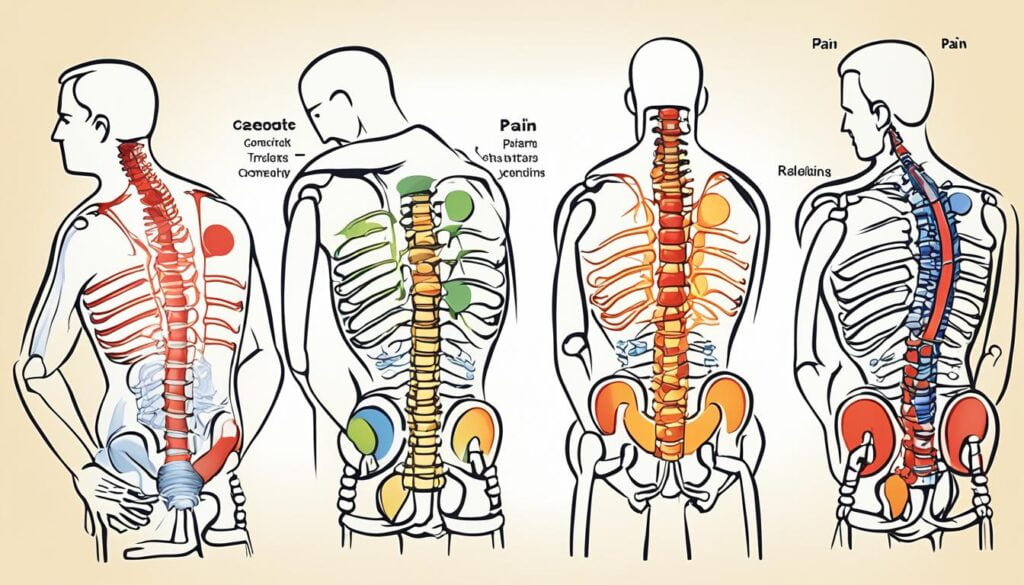
The pain can be in the lower, middle, or upper back. Knowing where and how your back hurts can help pick the right treatment.
Back pain is common, but seeing a doctor is a good idea if it's severe, lasts a long time, or has other concerning signs. A healthcare professional can figure out the cause and create a treatment plan just for you.
Exercise and Stretching for Back Pain Relief
Exercise and stretching are great for managing back pain. Activities like walking, swimming, and yoga strengthen the core and improve flexibility. They do this without putting too much stress on your back.
Low-Impact Exercises for Back Pain
- Walking: This simple exercise can help improve blood flow and reduce back pain.
- Swimming: The buoyancy of water takes pressure off your back, making it a great low-impact option.
- Yoga: Gentle yoga poses can help stretch and strengthen the muscles that support your back.
Stretches to Alleviate Back Pain
- Touching your toes: This simple stretch can help lengthen the hamstrings and relieve lower back tension.
- Cobra pose: This backbend can help open up the front of the spine and improve flexibility.
- Cat-cow pose: This gentle movement can help mobilize the spine and reduce stiffness.
- Child's pose: This restorative pose can help release tension in the lower back and hips.
Start slowly and listen to your body. Gradually increase the number of repetitions as the exercises become easier. If you have ongoing back pain or a recent injury, consider consulting a physical therapist or healthcare professional.

Proper Posture and Ergonomics
Keeping the right posture is key to avoiding and managing back pain. Bad posture, whether sitting, standing, or walking, can make back pain worse. Having a well-set workstation helps by placing the computer screen at eye level and using a supportive chair.
About 80% of people will have back pain at some point, often from bad posture. Studies also show that good posture cuts the risk of musculoskeletal issues by up to 80%. Bad posture is linked to 85% of back, neck, and shoulder discomfort, tension, and long-term health problems.
To better your posture and set up an ergonomic workspace, follow these tips:
- Adjust your desk and chair so your computer screen is at eye level, easing neck and back strain.
- Use a chair that supports your lower back and lets your feet rest flat on the floor.
- Stretch and move regularly to avoid the back pain that comes with sitting too long.
- Think about using a standing desk or an adjustable one to switch between sitting and standing during the day.
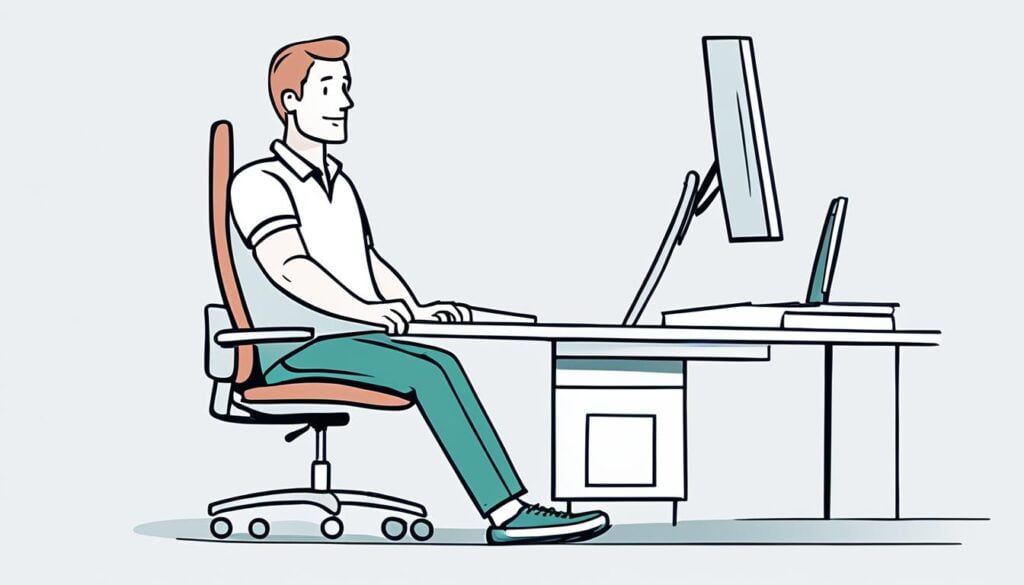
By focusing on proper posture and ergonomics, you can lessen back pain and boost your comfort and health.
Hot and Cold Therapy for Back Pain
Using hot and cold therapy can help manage back pain at home. Ice packs and heat therapy can target the root causes of pain. They offer relief by reducing inflammation and easing discomfort.
Using Ice Packs for Back Pain
Ice packs can lessen inflammation and numb back pain. They do this by making blood vessels smaller and slowing down nerve signals. This cooling effect helps ease sharp back pain. To use ice packs well, put them on the sore spot for 15-20 minutes a few times a day.
Applying Heat Packs for Relief
Heat therapy, on the other hand, boosts blood flow and relaxes muscles. It gives quick relief. Use heat packs, warm baths, or heating pads to ease stiffness and calm muscle spasms. Keep the heat warm but not too hot, and use it for 15-30 minutes at a stretch.
Switching between hot and cold therapy can work best for back pain. Using ice and heat together can help relieve pain and aid healing.
Always use these therapies safely and as directed. Don't use extreme temperatures on your skin, and stop if you feel any discomfort or skin issues. If your back pain doesn't get better or gets worse, see a healthcare professional for help.
Pain Relief Creams and Ointments
Over-the-counter pain relief creams and ointments can help with back pain at home. Menthol-based creams have a cooling effect that dulls pain. CBD creams can also help with pain and inflammation. These treatments work well with other therapies for better back pain management.
Menthol-Based Creams for Cooling Effect
Menthol-based creams like Tiger Balm and Dr. Blue Cool Gel have an organic compound. This compound makes the area cool, numbing the pain. About one in five Americans use these creams for back pain relief.
CBD Creams for Back Pain Relief
CBD creams are becoming more popular for pain and inflammation relief. Research on CBD for back pain is ongoing but shows promising results. Over 16 million adults in the U.S. have chronic back pain. Many are trying CBD creams as a natural pain relief option.
When using pain relief creams or ointments, always follow the instructions. If the pain doesn't get better or gets worse, talk to a healthcare professional.
Massage Therapy for Back Pain Management
If you're dealing with back pain, massage therapy could help. It can offer short-term relief for some people. But, its long-term effects are still being studied.
Massage uses techniques like kneading and friction to relax muscles and improve blood flow. This can make pain and discomfort less for a while. But, the evidence for using massage on chronic lower back pain is not strong.
Even without strong long-term evidence, many doctors see massage as a safe, natural way to handle back pain. When combined with other treatments like exercise and pain meds, massage can help a lot with healing and relief.
How well massage works for back pain can differ from one person to another. The massage type, the therapist's skill, and the back pain cause all affect the results. If you're thinking about trying massage, find a licensed therapist who can customize the treatment for you.
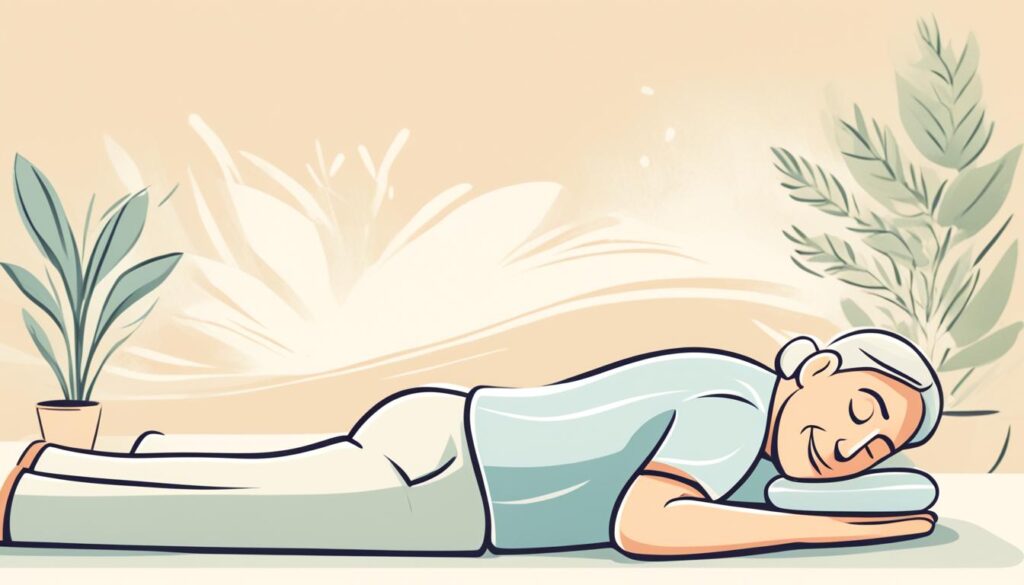
There are also other massage types that might help with back pain, like trigger point massage and sports massage. These focus on specific muscles and spots to ease pain and tension.
While massage can be a useful tool for back pain, it should be part of a complete treatment plan. Work with your doctor to create a plan that addresses the root of your back pain for the best outcomes.
Herbal and Natural Remedies for Back Pain
If you're looking for natural ways to ease back pain, consider herbal and homeopathic remedies. Arnica is a plant-based option that has been used for centuries. It helps with muscle aches, pain, and swelling.
Arnica for Muscle Pain and Swelling
Arnica is a top choice for back pain because it's thought to reduce inflammation and ease pain. Though not all studies support its benefits, many people find it helpful. They use arnica creams or gels on sore or swollen back muscles.
To use arnica, apply a small amount to the sore area and massage it in. Always follow the product's instructions and don't use it on broken skin. Some might also take arnica supplements, but check with a healthcare professional first.
Other natural remedies like ginger, turmeric, and essential oils might also help with back pain. But remember, they shouldn't replace medical care for serious or ongoing back pain.

If your back pain is severe or doesn't go away, see a healthcare provider. They can find out what's causing it and help you with a full treatment plan. With the right mix of natural remedies, lifestyle changes, and professional care, you can feel better and improve your health.
Footwear and Orthotics for Back Pain Relief
The shoes you wear can greatly affect your back pain. Shoes with good arch support and low heels can ease back strain. Sometimes, custom orthotics are needed to help your feet align right, which can lessen back pain.
Studies show that the right footwear and orthotics are key to easing back pain. More people are looking to buy products that help with back pain, focusing on shoes and orthotics. Online shopping trends highlight what buyers want, like a good shopping experience and tracking data for back pain products.
Experts suggest heels should be under 2 inches to keep your spine aligned. Shoes for running with lots of cushioning and a rocker bottom are good for those with back issues. Sandals with arch support are better than flip-flops or shoes with a negative heel, which can make back pain worse.
If back pain doesn't get better or gets worse, see a podiatrist or pedorthist. They can pick the right shoes and orthotics for you, giving your feet and back the support they need.

Choosing the right footwear and orthotics can really help with back pain and boost your health. Take your time to find the best fit and support for your feet. This could be the relief you've been looking for.
Improving Sleep Quality for Back Pain
Getting quality sleep is key when you have back pain. Some sleeping positions can help keep your spine aligned. This reduces strain on your back. [https://www.webmd.com/back-pain/sleep-tips-for-back-pain]Sleeping on your side with a pillow between your knees or on your back with a pillow under your knees can ease back pain.
Improving your sleep quality can also help manage back pain. In fact, research shows that chronic lower back pain often leads to sleep issues. People with chronic lower back pain are 58% more likely to have sleep problems than those who sleep well.
Sleeping Positions for Back Pain Relief
- Lie on your side with a pillow between your knees to keep your spine aligned.
- Sleep on your back with a pillow under your knees to support the natural curve of your spine.
- Avoid sleeping on your stomach, as this can put additional strain on your back.
Having a supportive, medium-firm mattress can also help with back pain. A 2021 study found that a new medium-firm mattress can cut back pain symptoms in half.
By adopting these sleep-friendly habits, you can better your sleep quality and ease your back pain. If your symptoms don't get better or get worse, see a healthcare professional for help. They can give you a proper check-up and a treatment plan tailored to you.
Diet and Nutrition for Back Pain Management
The foods you eat can greatly affect your back pain and inflammation. Eating anti-inflammatory foods can help manage back pain. But, eating too many processed foods, added sugars, and unhealthy fats can make back pain worse.
Anti-inflammatory Foods for Back Pain
Eating a diet rich in plants and omega-3 fatty acids from coldwater fish like salmon, mackerel, sardines can reduce inflammation and ease back pain. Herbs and spices like basil, cinnamon, ginger, garlic, and turmeric are also great for fighting inflammation. Foods such as avocados, nuts, lean proteins, beans, and cocoa can also help reduce back pain.
Foods to Avoid for Back Pain Relief
It's also key to avoid foods that can increase inflammation and make back pain worse. This includes processed foods, fast foods, saturated fats, white bread, sugary snacks, and fried foods. Cutting these out can help reduce your back pain.
Keeping a balanced, nutrient-rich diet is crucial for managing back pain. Eating anti-inflammatory foods and avoiding inflammatory ones can greatly improve your health and life quality.
Stress Management and Relaxation Techniques
Dealing with back pain can be tough on both your body and mind. Adding stress management and relaxation to your daily life can help a lot. These methods help you handle stress and tension, which can make your back pain worse.
Mindfulness and Meditation for Back Pain
Mindfulness meditation and other meditative practices are great for back pain. They help you stay in the moment and listen to your body. Regular meditation can slow down your heart rate, lower blood pressure, and improve digestion. All of this can help ease the strain on your back.
Breathing Exercises and Progressive Muscle Relaxation
Deep breathing and progressive muscle relaxation are also good for back pain. Deep breathing can quickly lower stress levels. Progressive muscle relaxation involves tensing and relaxing muscles to release tension. These methods can help control blood sugar, reduce stress hormones, and increase blood flow to muscles, offering overall relief.
Try different relaxation techniques to see what works for you. With regular practice, you can better manage stress and feel more calm and balanced. This can help you recover from back pain.
When to Seek Medical Attention for Back Pain
Many back pain cases can be handled at home. But, some times, you need to see a doctor. This is true if your back pain is severe, doesn't go away, or gets worse. If you have symptoms like new or worse bowel/bladder issues, weakness in your limbs, or trouble walking, you should get help.
About one in five Americans has had back pain in the past month. Most low back pain goes away in four to six weeks, with or without treatment. Knowing when you need a doctor's help is key.
- Severe, persistent, or worsening back pain
- New or worsening bowel/bladder issues
- Weakness in the limbs
- Gait and balance problems
These "red flag" symptoms suggest you might have a serious health issue. Seeing a doctor quickly is important. They can check for serious problems and decide on the best treatment. This could be medicines, physical therapy, or surgery.
If you're unsure about when to see a doctor for back pain or when to seek medical attention for back pain, don't wait. Getting help early can lead to better health and stop things from getting worse.
back pain relief at home
There are many home remedies and strategies for back pain relief. You can try using ice or heat, or do gentle stretches and exercises. These simple methods can help ease your pain and boost your back health.
Home Remedies for Immediate Relief
For quick relief from back pain, try these home remedies:
- Apply ice packs or cold compresses to the affected area to reduce inflammation and numb pain.
- Use topical pain relief creams or ointments containing ingredients like menthol or CBD to provide a cooling or soothing effect.
- Perform gentle stretches and exercises, such as those recommended by physical therapists, to increase mobility and blood flow.
Long-term Home Strategies for Back Pain Management
To manage back pain over time, try these strategies:
- Engage in regular low-impact exercises like walking, swimming, or yoga to strengthen the core and back muscles.
- Practice good posture and maintain proper ergonomics, especially when sitting for prolonged periods.
- Manage stress through relaxation techniques like mindfulness, meditation, or deep breathing exercises.
- Adopt an anti-inflammatory diet rich in foods like leafy greens, fatty fish, and turmeric.
- Ensure you get enough quality sleep, as poor sleep can exacerbate back pain.
By using these home-based methods, you can manage and possibly reduce your back pain over time.
Conclusion
Managing back pain at home is possible with a mix of techniques and lifestyle changes. Using home remedies for back pain relief can help ease your pain and boost your health. Regular exercise, stretching, good posture, and ergonomics are key strategies to consider.
Natural remedies like herbal supplements, hot and cold therapy, and massage can also help. Eating well, sleeping better, and using stress-reducing methods like mindfulness and meditation are important too. These steps form a complete plan for back pain relief.
If your pain doesn't get better or gets worse, seeing a doctor is important. Working with healthcare experts ensures any health issues are treated and your care plan is right for you. By using self-care and professional advice, you can manage your back pain and live better.
FAQ
What are the common causes of back pain?
What are the different types of back pain?
What exercises and stretches can help alleviate back pain?
How can proper posture and ergonomics help manage back pain?
How can hot and cold therapy provide relief for back pain?
What types of pain relief creams and ointments can help with back pain?
Can massage therapy be beneficial for back pain management?
What are some herbal and natural remedies that may help with back pain?
How can proper footwear and orthotics help with back pain?
How does sleep quality impact back pain?
How can diet and nutrition affect back pain?
What stress management and relaxation techniques can help with back pain?
When should I seek medical attention for back pain?
What are some effective home remedies for immediate back pain relief?
What are some long-term home strategies for managing back pain?
Stick to a mix of strategies like exercise, proper posture and ergonomics, stress management, and dietary changes. This can help lessen the frequency and severity of back pain over time.
Source Links
- 12 fast and effective back pain home remedies
- Ways to Relieve Back Pain
- Back pain: Causes, treatments, and when to contact a specialist
- Back pain - Symptoms and causes
Finding the Best Lower Back Pain Specialist Near You
Finding the right lower back pain specialist near you in India can greatly improve your health. This guide will help you find a specialist who offers personalized care and relief from your symptoms.
If you have a herniated disc, sciatica, or chronic lower back pain, finding the right spine specialist is key. Working with an experienced professional who knows how to treat spine and lower back issues can help. They can suggest various treatments and create a plan to fix the cause of your pain.
In India, there are many back pain specialists like orthopedists, neurosurgeons, physical therapists, and pain management experts. Knowing about these specialists and their expertise helps you choose the best one for your needs.
Lower Back Pain: A Common Concern
Lower back pain is a common issue that affects millions of people around the world. It can come from many sources, like muscle strain, herniated discs, sciatica, or other health problems. Symptoms include dull aches, sharp pains, stiffness, and less mobility, which can really affect daily life. Knowing what causes and signs of lower back pain is key to finding the right treatment.
Causes and Symptoms of Lower Back Pain
Some common causes of lower back pain are:
- Muscle strains or sprains
- Herniated or bulging discs
- Sciatica, a condition caused by compression or irritation of the sciatic nerve
- Arthritis or other degenerative conditions
- Injury or trauma, such as from a fall or accident
The symptoms of lower back pain can vary a lot, but they might include:
- Dull, aching pain in the lower back
- Sharp, shooting pains that radiate down the legs
- Stiffness and limited range of motion
- Muscle spasms or tightness
- Numbness or tingling in the legs or feet
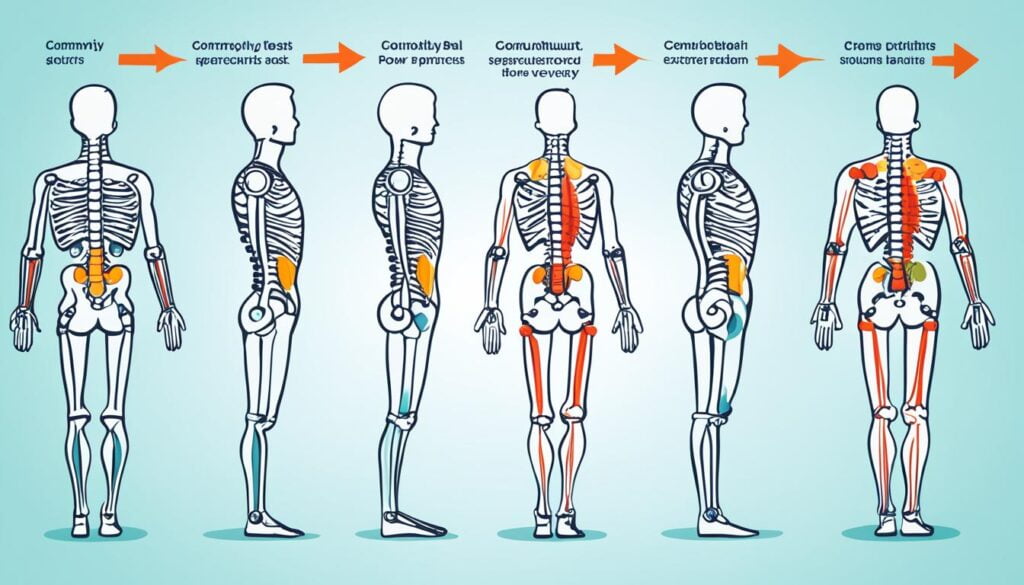
The severity and how long lower back pain lasts can vary a lot. It's important to see a doctor if the pain doesn't go away or gets worse. Getting help early can stop it from becoming a long-term problem and make life better overall.
When to Seek Professional Help
If you have mild lower back pain that goes away on its own, you might not need help. But, if the pain lasts more than a few days or gets worse, you should see a doctor. They can figure out what's causing the pain and create a plan just for you.
A 2018 study showed that seeing both a doctor and a chiropractor helped with back pain more than just seeing a doctor alone. Physical therapists can make a plan with exercises and stretches for you to do at home or in a clinic. Your doctor might send you to a specialist like a pain doctor, an orthopedist, or a rheumatologist, depending on your situation.
You should get help for lower back pain if it's ongoing or very bad, after an injury, if you're losing weight without trying, or if you have other symptoms. If your back pain is affecting your life, don't wait to seek medical attention for back pain. The right treatment can make you feel better and improve your life.
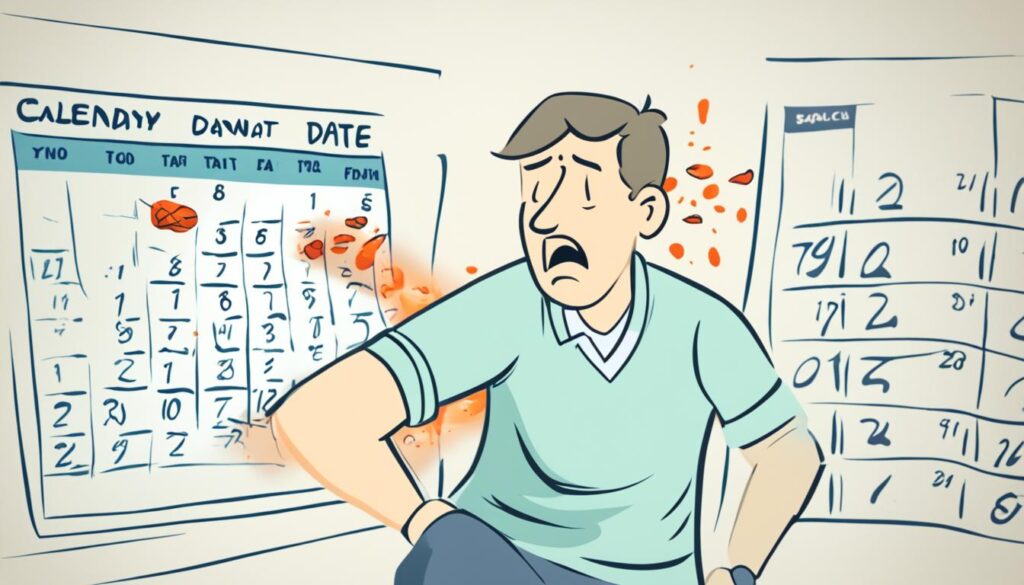
- Persistent or severe lower back pain
- Worsening pain over time
- Numbness, tingling, or weakness
- Pain after an injury
- Unexplained weight loss
- Pain that significantly impacts your quality of life
Primary Care Doctor: The First Line of Defense
When you have lower back pain, your primary care doctor is usually the first one you see. They know your medical history well and can check you thoroughly to find what's causing your pain. Primary care physicians can suggest treatments, send you to specialists, or order tests like X-rays or MRIs to help figure out what to do next.
Role of Primary Care Physicians in Managing Lower Back Pain
Primary care doctors are key in handling lower back pain. They can:
- Do a physical check-up to see what's causing and how bad your back pain is
- Order tests like X-rays or MRIs to find the real cause
- Suggest first treatments, like over-the-counter drugs, heat or cold therapy, or physical therapy
- Send you to a specialist, like an orthopedist or a pain management doctor, if you need more help
- Keep an eye on how you're doing and change your treatment if needed
Working with your primary care doctor for back pain ensures your back pain gets checked out right. You'll get a treatment plan that fits your needs.
Chiropractic Care: A Non-Invasive Approach
If you're dealing with lower back pain, think about chiropractic care. Chiropractors focus on musculoskeletal issues, like lower back pain. They use spinal adjustments to fix the spine and ease nerve pressure, which may be causing your pain.
Chiropractic care is a non-invasive, drug-free way to ease chiropractor for back pain. It helps improve mobility and function. Studies show that staying active can greatly improve your health.
Being overweight can make back pain worse. Losing weight can help. Your chiropractor might suggest chiropractic treatment for lower back pain like NSAIDs to help with pain.
Your chiropractor will look at your health history and create a treatment plan. They'll perform adjustments to fix the cause of your non-surgical back pain treatment. Many people find their pain goes down, they move better, and heal faster with chiropractic care.
Chiropractic care can work with other treatments like physical therapy and massage. This gives you a full plan for back pain relief. With your chiropractor, you can make a plan that fits you and helps your spinal health.

Orthopedists: Specialists in Musculoskeletal Disorders
If you're struggling with ongoing lower back pain, seeing an orthopedic doctor is key. These specialists know how to handle injuries and disorders of the musculoskeletal system, like the spine. They use tools like X-rays, MRIs, and CT scans to find out what's causing your pain.
Diagnostic Techniques and Treatment Options
An orthopedic doctor for back pain might suggest treatments like physical therapy or medication to ease your symptoms. For serious cases, surgery might be needed to fix any structural problems.
- Average Clinic Fees for Orthopedic Doctors range from ₹250 to ₹1000.
- The top-rated doctors in this field have Lybrate Ratings ranging from 86 to 91.
- The average overall rating for orthopedic specialists is 4.4 out of 5 based on 1650 ratings and reviews.
Looking for the right spine specialist doctor can be tough, but orthopedists are a great choice. They offer a full approach to treating musculoskeletal disorders. This can lead to the relief you've been looking for from your back pain treatment options.
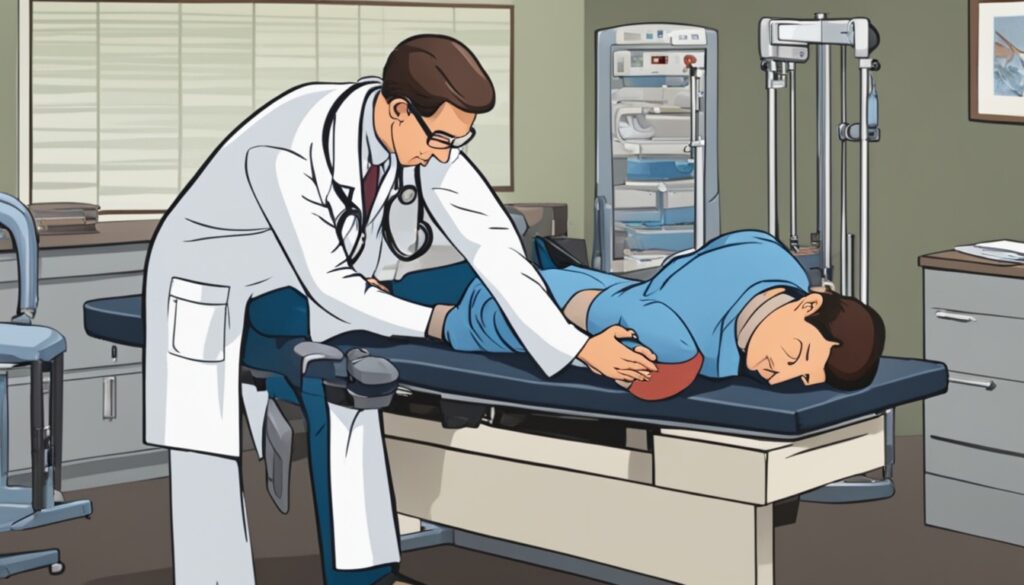
Physical Therapists: Restoring Movement and Function
If you're dealing with lower back pain, a physical therapist could change your life. They are experts in making you move better, function better, and feel less pain. They create a plan just for you, using exercises, stretches, and manual therapy to help your lower back.
Exercises and Stretches for Lower Back Pain Relief
Physical therapy can fix muscle imbalances, make you more flexible, and strengthen your core. This can help ease your lower back pain and stop it from coming back. Here are some exercises and stretches your therapist might suggest:
- Core strengthening exercises like Cat-cow Pose, Crunches, High and Low Planks, and Pelvic Tilt to stabilize your core muscles and reduce strain on your back.
- Postural training exercises such as Calf Stretching, Pelvic Tilts, and Seated Squats to help correct your posture and realign your body.
- Hamstring Stretches, Planks with Leg Lifts, Squats, and Downward Dog to strengthen your lower back muscles and promote lumbar spine stability.
Physical therapy does more than just ease pain. It also boosts your mobility, flexibility, and functioning. The main goal is to make you strong and stable, so you can move easily and confidently.

When picking a physical therapist, make sure they're well-trained, know how to treat lower back pain, and are in your insurance network. With the right therapy plan, you can manage your lower back pain and improve your life.
Pain Management Specialists: Addressing Chronic Pain
If you're dealing with ongoing or chronic lower back pain, a pain management specialist might help. These experts are trained to handle complex pain issues. They use a mix of medicines, procedures like epidural injections, and advanced therapies for long-term relief.
Pain management doctors are pros at treating various pains, including back pain, slipped disc, and knee pain. They know how to tackle chronic pain and create a plan just for you. This plan aims to find and fix the source of your pain.
Chronic pain can really change your life, making everyday tasks hard and lowering your quality of life. A pain management specialist can offer different treatment options to help you manage your pain. This way, you can take back control of your health.

Rheumatologists: Treating Autoimmune-Related Back Pain
If you're dealing with ongoing lower back pain, a rheumatologist might be the right choice. Rheumatologists are experts in treating musculoskeletal and autoimmune disorders that cause back pain. They can help with conditions like rheumatoid arthritis and ankylosing spondylitis by addressing the autoimmune factors.
Rheumatologists know how the immune system, inflammation, and muscles work together. They use tests like blood work and imaging to find the cause of your pain. They aim to treat the root cause, not just the symptoms.
Working with a rheumatologist means getting personalized care for your autoimmune back pain. They can change your treatment plan as needed and help you manage flare-ups. They focus on a whole approach to help you manage pain and improve your life.
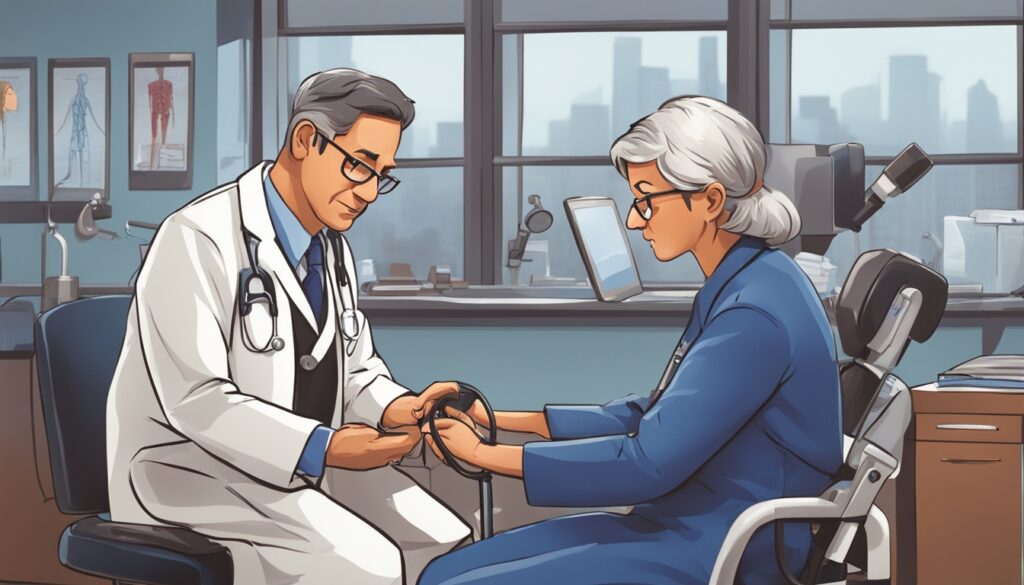
If you have unexplained back pain or joint stiffness, see a rheumatologist. Their expertise is key in treating autoimmune back pain. They can help you live without pain and discomfort.
Massage Therapy: Complementary Treatment for Lower Back Pain
If you're dealing with lower back pain, massage therapy could help. Skilled therapists use techniques like Swedish, deep tissue, and trigger point therapy. These methods relax muscles, improve blood flow, and help the body heal.
Massage might not cure severe or chronic back pain alone. But, it can ease symptoms and make other treatments work better. Studies show that spinal manipulation in massage can help with low back pain. Also, massage can lower inflammation, which is linked to some chronic pain.
Benefits of Massage for Lower Back Pain
- Relieves muscle tension and stiffness
- Improves blood circulation and nutrient delivery to the affected area
- Releases endorphins, the body's natural pain-relieving chemicals
- Reduces inflammation and swelling
- Enhances flexibility and range of motion
- Complements other treatments, such as physical therapy or chiropractic care
Thinking about trying massage for your lower back pain? Make sure to find a licensed therapist who can customize the treatment for you. With the right approach, massage can be a key part of managing and easing lower back pain.
Acupuncture: An Ancient Approach to Pain Relief
If you're dealing with lower back pain, acupuncture might be worth a try. It's an ancient practice from traditional Chinese medicine. Thin needles are put into specific spots on the body to help the flow of energy, or "qi," and aid healing.
Studies have found that acupuncture for back pain can work well with other treatments. In a 2012 study, nearly 20,000 people with chronic pain got better by half when they had real acupuncture. Those who got fake treatments or none at all didn't see the same results.
Another study in 2013 backed up acupuncture as a good choice for chronic lower back pain. It's a low-risk treatment, making it a good option for many people.
But, make sure to see a licensed acupuncturist for safe treatment. Sessions can cost from $60 to $130 each. Most health insurance doesn't cover it. You might need weekly sessions at first, then go to less often as you get better.
One study found acupuncture might work better for back pain than some pain meds. It's a safe method when done by a trained professional. But, it's not for people on blood thinners or with bleeding disorders because of the risks.
Thinking about traditional Chinese medicine for back pain? Talk to a licensed acupuncturist who is well-trained and certified. With the right expert, acupuncture could be a big help in easing your lower back pain.
Lower back pain specialist near me
If you're looking for top back pain doctors in India, start by asking your primary care doctor or physical therapist for recommendations. They can suggest reputable specialists in your area. This is a great way to find back pain experts who are well-regarded.
Online research can also help you find specialists near you. Look for doctors with a focus on lower back pain and read reviews from other patients. Make sure they accept your insurance and are close to your home or work.
Tips for Finding the Ideal Back Pain Specialist
- Ask your primary care doctor or physical therapist for referrals to trusted back pain specialists in your area.
- Search online for top-rated back pain doctors near you and read patient reviews to assess their qualifications.
- Confirm that the specialist accepts your health insurance plan and is easily accessible from your home or office.
- Consider the specialist's areas of expertise and treatment approaches to ensure they align with your specific back pain needs.
- Schedule a consultation to get a feel for the doctor's bedside manner and communication style, as this can impact your overall care experience.
By doing your homework and finding the right back pain specialist near me or best back pain doctors in India, you can get personalized care for your lower back pain. With the right healthcare provider, you'll be on your way to feeling better and improving your life.
Multidisciplinary Approach: Combining Treatments
For many, an integrated approach to back pain treatment is key to lasting relief. Working with a team of healthcare experts, like primary care doctors, chiropractors, physical therapists, and pain management specialists, helps tackle back pain from all angles. This team creates a holistic back pain management plan just for you.
Prevention: Maintaining a Healthy Back
Getting help from a professional is key for dealing with lower back pain. But, you can also prevent future pain by making healthy choices and exercising regularly. These steps can lower your chance of chronic back pain and boost your health.
Lifestyle Modifications and Exercises
Here are some tips to keep your back healthy:
- Keep a good posture when sitting and standing to support your spine and ease back muscle strain.
- Do regular strength training to work on your core muscles. This helps keep your spine stable and prevents injuries.
- Make sure you get enough calcium and vitamin D to fight osteoporosis, a common cause of back pain, especially in women.
- Wear shoes with a heel less than 1 inch to lessen back strain.
- Take breaks from sitting or standing for long periods to avoid muscle stiffness and back pain.
- Stop smoking to keep blood flowing to your spinal discs and prevent disc degeneration.
- Lift heavy things correctly to avoid muscle spasms and back pain.
- Keep a healthy weight to ease back strain and prevent spine tilting and stress.
- Do low-impact exercises like walking to keep a healthy weight and ease back pressure.
- Stretch every day to keep your spine healthy and flexible.
By following these lifestyle changes and exercises, you can prevent lower back pain, strengthen your back, and keep an active and healthy life.
Conclusion
Finding the right specialist for lower back pain in India can change your life. It helps you get lasting relief and improve your life quality. You can manage your pain by knowing the different healthcare professionals and treatment options. Also, taking steps to keep your back healthy helps a lot.
About 80% of people have back pain at some time, and it happens to over 90% of us at some point. But, most of the time, back pain goes away without surgery. By seeing a specialist like Dr.Chandril Chugh you can get help that fits your needs. This can lead to a full recovery and a better life.
For managing lower back pain, it's key to seek professional help. Know who can help you and make lifestyle changes for a healthy back. Working with your specialist and being proactive helps you find relief and live an active life.
FAQ
What are the common causes and symptoms of lower back pain?
When should I seek professional help for my lower back pain?
What role does a primary care doctor play in managing lower back pain?
How can a chiropractor help with lower back pain?
What treatments can an orthopedist offer for lower back pain?
How can physical therapy help with lower back pain?
What role do pain management specialists play in treating lower back pain?
How can a rheumatologist help with lower back pain?
What are the benefits of massage therapy for lower back pain?
How can acupuncture help with lower back pain?
How can I find the right lower back pain specialist near me in India?
What is a multidisciplinary approach to managing lower back pain?
What can I do to prevent future episodes of lower back pain?
Do regular exercises, keep good posture, and make lifestyle changes like managing stress and staying at a healthy weight. These can help prevent future back pain and boost your health.
Source Links
- Top lower back pain treatment Hospital in India : Book Appointment Online
- Best Back Pain Doctor in Jayanagar, Bangalore | QI Spine
- Lower Back Pain Treatment in Hyderabad | Back Pain Specialist
- Back Pain Treatment in Thane | The Spine Clinics

